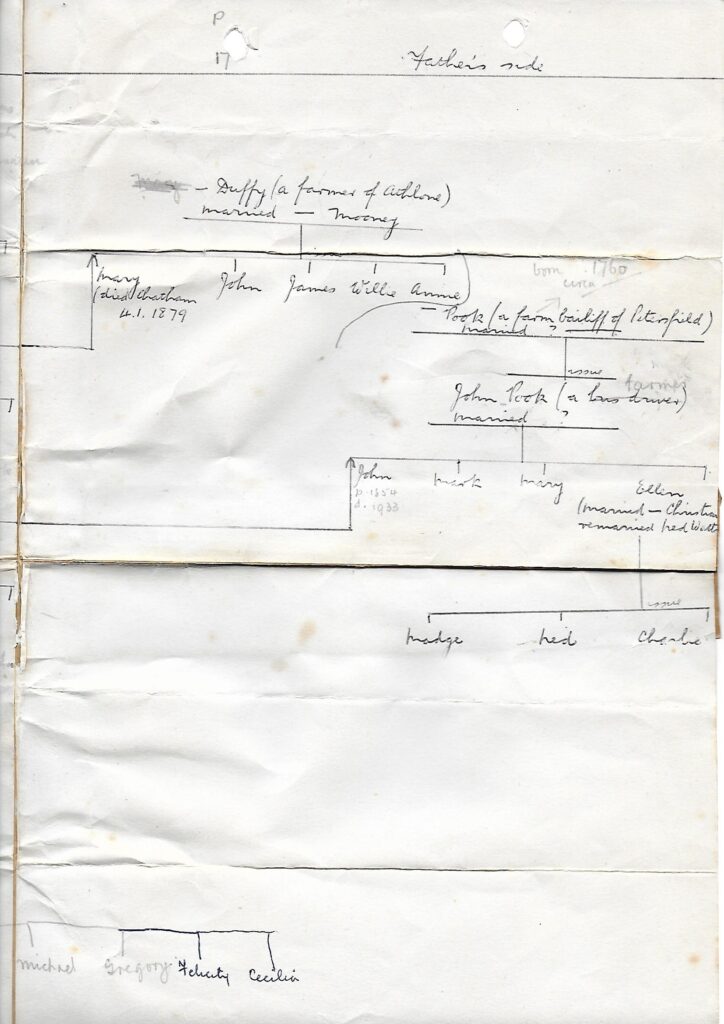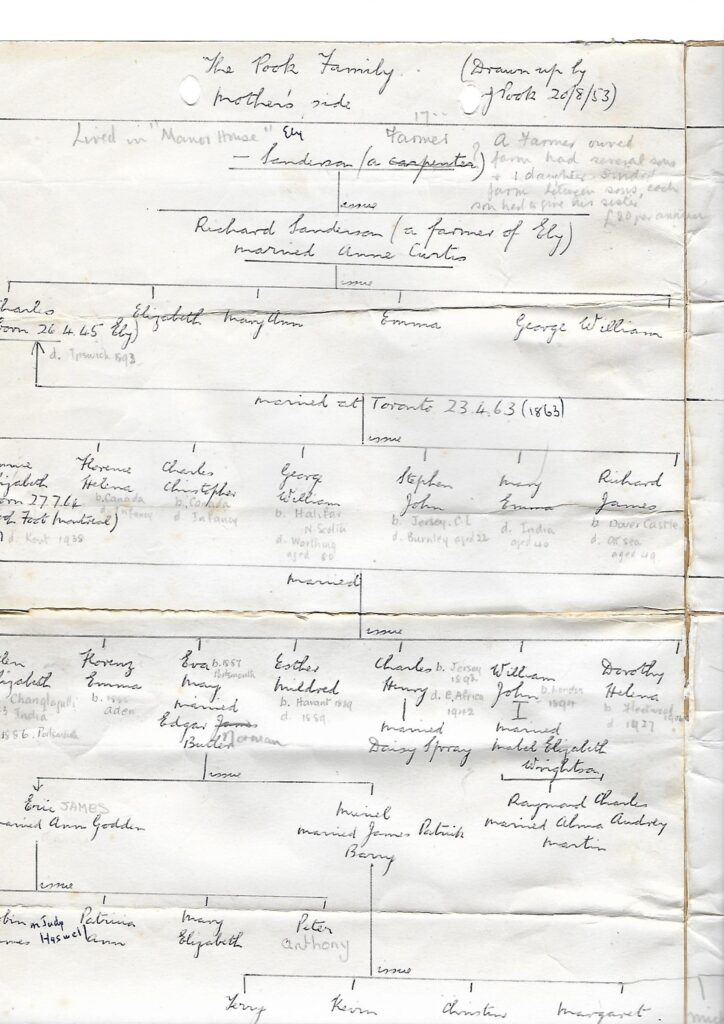This post is connected to the separate “Florenz Emma Pook” Post, in that our Great Aunt, Florenz Emma Pook is part of the wider Pook family. Those of you who knew Auntie Florry will not be surprised that I dedicated a separate post to her life. We are very fortunate that she left a written record of large parts of her life, in fact so much so that I felt it important that I dedicate a separate post to her. Indeed even very recently several more written records have appeared and who knows maybe more parts of her life have yet to appear, or be discovered. However this particular Post is mainly about the Pook family. Auntie Florry’s sister, Eva May Pook, our Grandmother has a more detailed and comprehensive entry under her married name of Butler.
It is fitting I think, to begin with a piece that Auntie Florry contributed to The South Lancashire Regimental News Letter, the Regiment that her Father served in for many years. The piece below is Auntie Florry’s take on the Pook family tree!
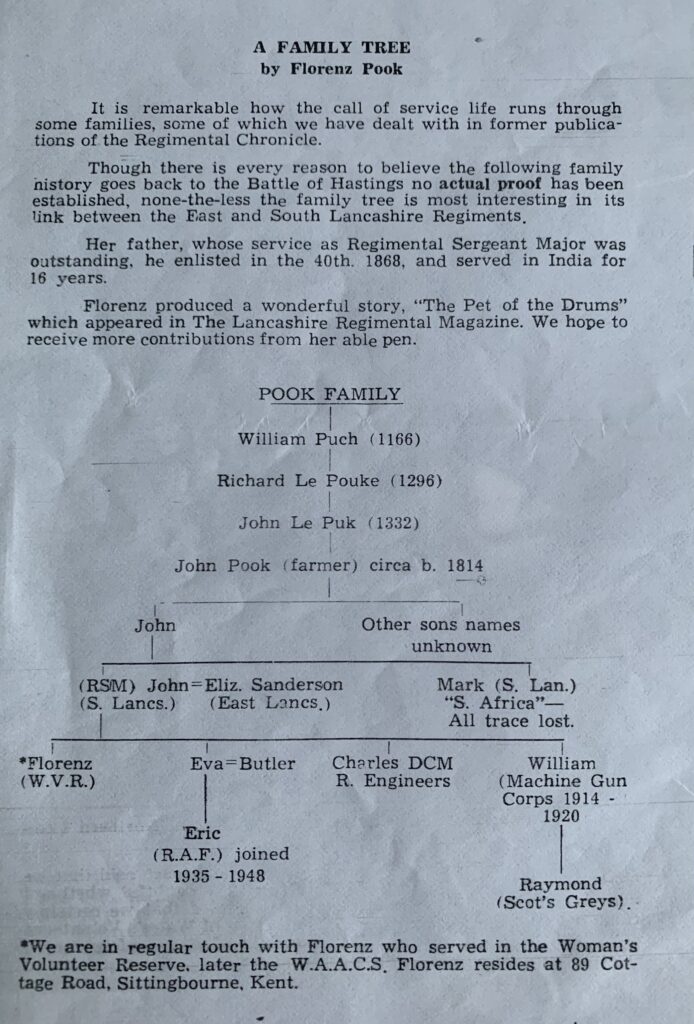
Aunty Florry’s brother William John Pook produced the hand written family tree below of both the Pook’s & Sanderson’s in 1953. Either he or someone else added the Barrys who were born after 1953.
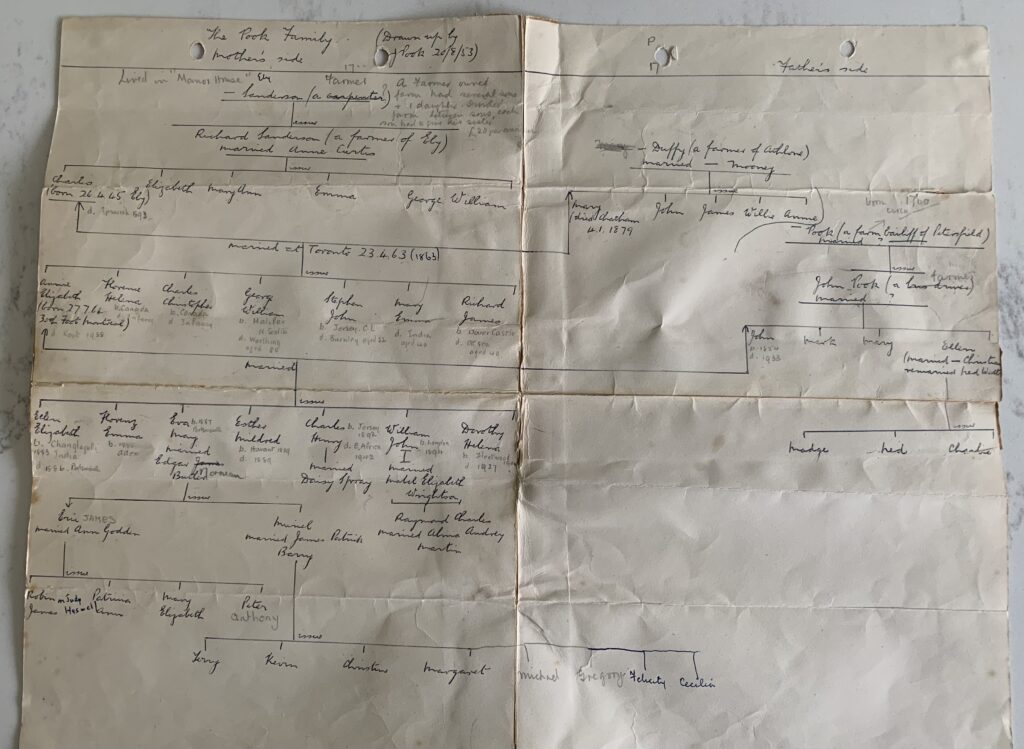
Our brother Kevin James Barry copied and updated William John Pook’s family tree in 1967 & 1985 it is reproduced below & probably makes for easier reading. For some reason he did not transcribe the Barrys onto the copied tree!?
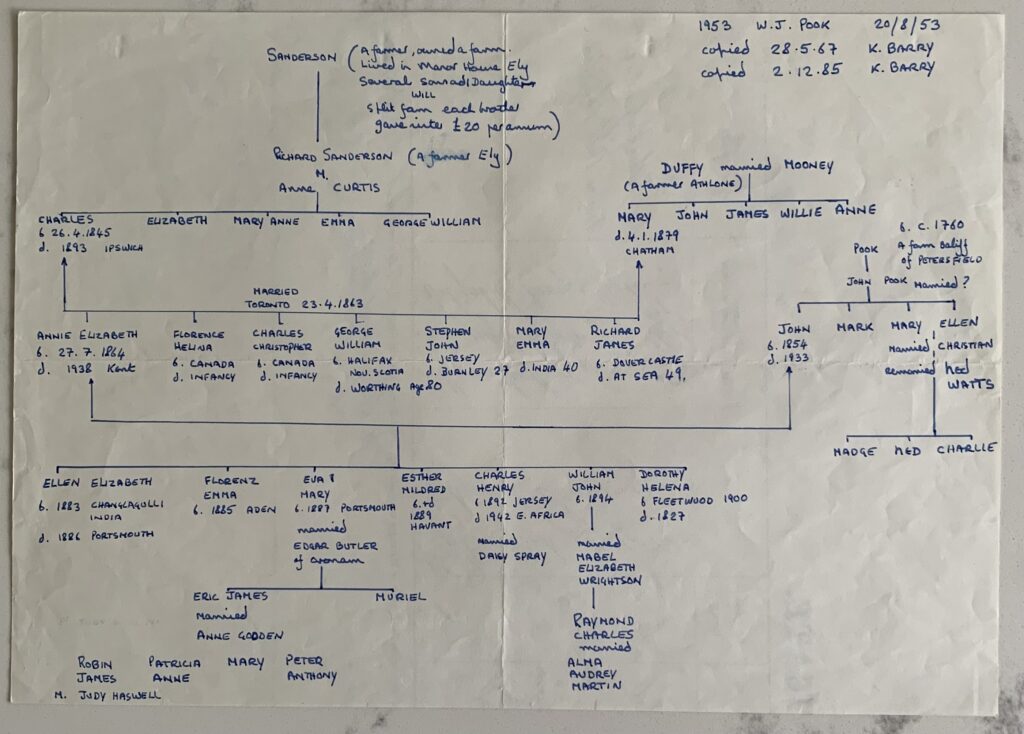
Most, if not all of the detail of the rest of the Pook family tree listed below has been made available to us through the diligent research of Patricia Butler (nee Payne), our cousin, affectionately known as Pat or Patsy, with whom we share a Grandmother, Eva May Pook. It is thanks to Pat’s diligent research and hard work that we can trace our Pook ancestry and history as far back as 1738!
Thomas Pook our Great, Great, Great, Great, Great Grandfather, labourer and butcher! – b about 1738, d 1814.
Thomas Pook was born about 1738 and died aged 76 in 1814; he was buried in Harting, Sussex. He married Susanna Kilsey on 6th May 1766 in Midhurst West Sussex. She was a Spinster from Midhurst, born 1755; Thomas’s occupation was labourer, and later apparently a butcher!
Apparently they were both 21 when they were married, but ages were sometimes guessed at, or a false age was given if it suited them. Susanna Pook was buried on the 4th May 1805 in Harting, Sussex.
As far as we can make out they had 5 children.
Thomas Pook born in 1767, Harting, West Sussex.
James Pook born 1770 and followed in his father’s footsteps as a labourer.
Sarah Pook, born 1772, Harting, West Sussex. (Soon to be our Ancestor in 25 years!)
Lucy Pook born 1783, died 1786.
William Pook, married 26.10.1796 (no proof that William is the son of Thomas and Susanna!
Great, Great, Great, Great Grandmother Sarah Pook, born 1772 Harting, Sussex, married one, James Newman eventually!!! Her life, times and family. (And why she is one of our ancestors!)
We are descended from our Great Great Great Great Grandmother Sarah Pook by her second child Thomas Pook who was born in 1797 (out of wedlock); her first child was also born out of wedlock, Sarah Pook born 1794. Thomas and Sarah Pook who were both born out of wedlock kept the Pook surname, Sarah for a while until she married, and Thomas for whatever reason kept the surname Pook and made it easier for us to trace our ancestry.
Sarah Pook (b 1772) married one James Newman (who may have been our Great, Great, Great Great Grandfather?) on 7th May 1803 in Rogate West Sussex. This was 9 years after she had given birth to her first illegitimate child, Sarah Pook (b 1794).
Sarah Pook senior and James Newman, once they were married, then had another 4 children who took their fathers surname Newman. James Newman, born 1804, William Newman born 1807, Lucy Newman born 1810, and Francis Newman born 1813. In 1851 Sarah Newman (nee Pook) aged 77 was living with her sons James & William Newman in Rogate, her husband James Newman died in Rogate, Sussex in 1834 aged 70 years.
Great, Great, Great Grandfather, Thomas Pook, (baseborn) born 1797 – died 1885, his life, times and family. (Thomas was born illegitimate, his mother was Sarah Pook born 1772
Thomas Pook was baptised on 3rd December 1797 in Rogate, West Sussex. He was an Agricultural Labour and eventually became a Farm Bailiff. He married Ann Sparshatt when she was 20 years old on 22nd April 1821 at Buriton, Hampshire.
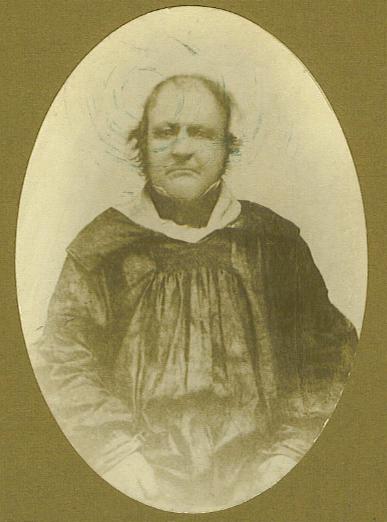
Thomas Pook born 1797. Our Great, Great, Great Grandfather
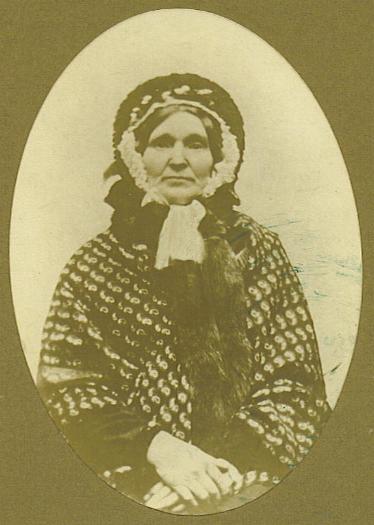
Ann Pook (nee Sparshatt) born 1801. Our Great, Great, Great Grandmother.
1866 – By now Thomas is a Farm Bailiff at Nursted, and in 1881 is living at Sheet, Hants, which is very near to Petersfield and Buriton.
Thomas and Ann’s children.
Thomas Pook was born on the 24th June 1821, (born 2 months after his parent’s marriage!!) He was buried on the 20th May 1911; he was nearly 90 years of age when he died.
John Pook was born in 1825 and baptized on the 23rd October 1825. He died on the 1st March 1858 of phthisis, (a wasting disease of the lungs) his brother Mark was also to die of the same disease in 1867.
William Pook was baptized on the 20th July 1832 in Buriton. Hants, he died in the early 1900s.
Mark Pook was born in 1837 and died of phthisis on 15 August 1867 in Stanbridge; Buriton aged 30 from phthisis like his brother John.
Charles Pook was born on the 17th September 1842 at Nursted, and was baptised on 6th November, 1842 at Buriton, Hants.
Great, Great Grandfather, John Pook, born 1825 – died 1st March 1858, his short life, times and family.
John Pook was born in 1825 and baptized on the 23rd October 1825 at Buriton, Hampshire. He married one Ann Martin (born 1829) on 28th October 1848 in Harting, Sussex. During his short life he was an agricultural labourer and then later a dockyard labourer.
John Pook & Ann Martin’s Wedding Certificate appears below.
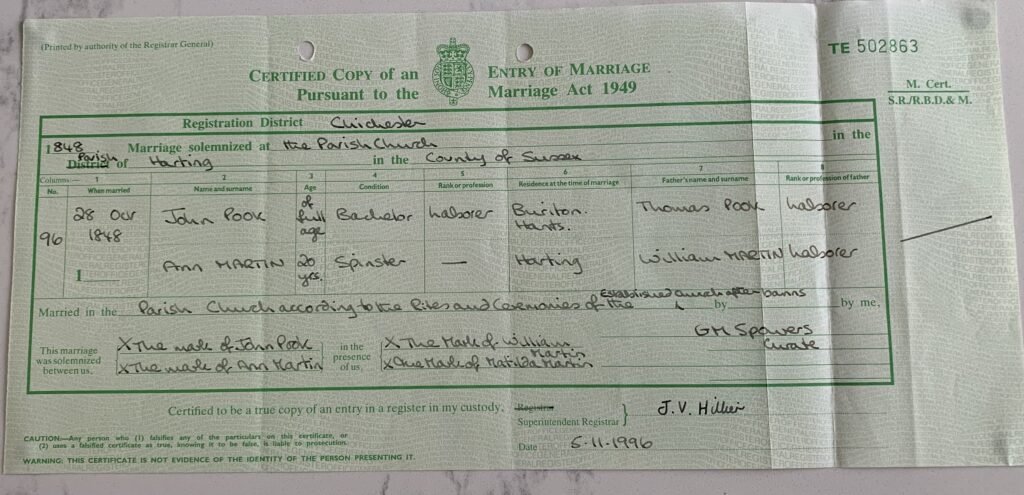
They had 5 children in their short life together including our Great Grandfather John Pook, born 1854.
Mary Ann Pook born 1850.
Ellen Pook born 1852.
John Pook born 25th October 1854, Nance’s Row, Portsea, Portsmouth. Died 5th November 1932 in Wimbledon, London aged 78 years, buried Wandsworth Cemetery, Magdalen Road, Wandsworth, London.
Twins, William & Mark Pook were born on the 25th June 1858 at Trafalgar Place, Portsea and baptised on the 1st August 1859 at St Marys, Portsea.
William, twin of Mark was born at 6 pm, and Mark was born at 6.20 pm, the twins were baptised on 1st August 1859. William died about a year later and was buried on 26th August 1859. Their father John Pook (b 1825) died 6 months before they were born on 1st March 1858 of phthisis (a wasting disease of the lungs) at his own residence, 3 Coburg Street, Fratton, Portsmouth. He was aged only 33.
His wife Ann Pook (nee Martin) died of Typhoid Fever at Nances Row, Portsea, Hampshire in 1865 seven years later when she was aged 35. With John and Ann both dying in their 30s I am led to believe that Ann Pook’s mothers family, the Martins brought up John and Ann Pook’s 5 children.
Mark the surviving twin joined the Army on the 24th October 1870. He joined the 82nd – 2nd Battalion of Foot of the South Lancashire’s at Portsmouth, where he gave his age as 14 years. He was described as having a fresh complexion, light brown hair and grey eyes. His height was then given as 5’ 9”, and his religious denomination as Church of England. His former trade or occupation was given as “musician”.
(In 1881 the 82nd Regiment became the 2nd Battalion of the South Lancs Regiment). On the 19th November, 1870, he was appointed as a “Drummer on the 13th June, 1871. He moved with the Regiment to Aldershot, on the 20th September, 1872 to Chatham, Kent, on the 1st July 1874 back to Aldershot and on the 1st August, 1874, to Shorncliffe, Folkestone, Kent.
From 1875 to 1880 Mark Pook was stationed with his regiment in Ireland at Buttevant, Cork and in April 1877 they were in Limerick, Ireland, afterwards going to Dublin. On the 6th February, 1879, he was in confinement, awaiting trial, and was found guilty of insubordination on the 13th February, 1879. He was released on the 8th May, 1879. By March, 1880, the Regiment were back at Aldershot, and they went to Devonport on the 20th October, 1881. In December, 1881, Mark was diagnosed as having the early stages of Syphilis.
On the 11th February, 1882, Mark Pook was promoted to Corporal, on the 30th December, 1882, he was passed as being fit for re-establishment despite having varicose veins in his right leg, which were not considered such as to prevent him doing his duty as a soldier. On the 21st February, 1883 he married Ellen Dalton (born 1856) at Stoke-Damerel, Devonport. He was never put on the married roll. The 2nd Battalion of the South Lancs Regiment now embarked for South Africa and arrived in Natal on the 5th August, 1884. On the 1st November, 1885, Mark Pook was promoted to Sergeant. On the 4th September, 1884, the Regiment was in Zululand. Their son, George Frederick Pook was born on the 31st March, 1886, at Pietermaritzburg, South Africa.
On the 10th February, 1887, the 2nd Battalion arrived in the Straits Settlements, and at Singapore on the 8th March 1887.The 2nd Battalion left Singapore aboard HMS “Himalaya” on the 14th January, 1889, and arrived at Gibraltar on the 21st February 1889, arriving back in Gosport, England on the 21st May, 1890. On the 3rd June 1890 Mark Pook discharged himself from the 2nd Battalion of the South Lancs Regiment after 18 years service, prior to which he was court martialled and demoted for drunkenness. On the 1891 census he was living at 19 Granaby Street, Stoke Damerel, Devonport, with his wife and son, occupation listed as army pensioner. X
On 17th May, 1892, Mark Pook joined the 4th Battalion of the Liverpool Regiment at Warrington, having signed the declaration and made his oath at Devonport on the 16th May 1892. His description at this time is height 5’11”, fresh complexion, blue eyes, light brown hair, heart tattooed on right forearm, transfixed by an arrow, and his religious denomination as C of E. On the 7th March, 1895, he was in confinement and tried by the DCM? for drunkeness on duty, and sentenced to be reduced to the ranks and was posted as Private. On the 10.4.1895 he was discharged – his services being no longer required. On the 23.4.1900 he joined the Royal Lancashire Reserve Regiment at Devonport for services in the Infantry. He was discharged from the Royal Lancashire Reserve Unit on the 22nd April 1901 at Aldershot. His wife’s address given as 4 Tamar Wharf, Marine Town, Devenport, Devon.
By the 1901 census he is living at 39a James Street, Devonport, on his own, occupation listed as soldier and described as married. In 1911 Mark is still living on his own, boarding with the Hill family in Devonport, occupation pensioner soldier and described as married.
Mark Pook, Army Pensioner, aged 73, died of heart disease (myocarditis) & senile dementia on the 14.2.1931 at Ford House, Devenport, Plymouth. His death was registered by his son Frederick George Pook on the 17th February 1931, his address was 5 Tamar Road, Devenport.
There is a death entry for a Mark B Pook aged 73 years at Devonport, ref 5b 576. The date ties up nicely with his date of birth, but don’t know where the middle initial ‘B’ comes from.
Great Grandfather, John Pook, born 25th October 1854 – died 5th November 1932 , his life, times and family
He married Annie Elizabeth Sanderson in 1882; she was born in Montreal, Canada on 27th July 1864. She died on the 7th February 1938 and is buried with her husband John Pook in Wandsworth Cemetery London.
John Pook was born on the 25th October, 1854 at Nance’s Row, Portsea, Portsmouth, in the County of Southampton (now part of Hampshire). He died on the 5th November 1932 in Wimbledon; London aged 78 years and is buried in Wandsworth Cemetery, Magdalen Road, Wandsworth, London.
On the 26th January1867 John joined the 40th, 2nd Somerset Regiment of Foot at Portsmouth, when he was 12 years and 3 months old. (He incorrectly gave his age as being 14 years and 9 months). No bounty and free kit! His height was then 4’9”, fresh complexion, hazel eyes and brown hair. Religious denomination was left blank. (The 40th Foot amalgamated with the 82nd Foot in 1873, to form the South Lancs – the 40th Foot being the 1st Battalion and the 82nd Foot being the 2nd Battalion).
April, 1867, the regiment moved to Plymouth and then to Aldershot in November 1867. In October 1868 they moved to Carlisle. In December 1869 they had moved to Southern Ireland, Mullingar, in February 1871 they moved to the Curragh and in August 1871 to Dublin. In September John Pook was back in the Curragh.
On the 5th October, 1872, the Regiment embarked for India from Queenstown (Now Cobh in Cork) on H.M.S. Serapis. During the voyage H.M.S. Serapis went aground in the Red Sea and the men were engaged in taking hundreds of tons of coal out of the ship in order to lighten her sufficiently to refloat her. They arrived at Bombay on the 8th November 1872.

The hand drawn picture above has been in the Pook/Sanderson families’ possession for some time and was then passed into the Barry family some years ago for safe keeping. This was the Troopship that John Pook our Great Grandfather travelled in on his journey to India in 1872 with his Regiment, the South Lancashires. This picture was drawn by one S. Sanderson, Artist, we presume he or she was a relation to our Great Grandmother Annie Elizabeth Sanderson. As yet we have not established which Sanderson was the Artist.
The first station in India was Lucknow, and the 40th were there for three years.
On the 28th December 1874, John Pook was promoted to Corporal. According to the Army medical records, John Pook was treated for Gonorrhea in May 1875, when he was 21 years of age. The Regiment moved to Dum Dum near Calcutta in 1875, where he was again treated for Gonorrhea in 1876!
On the last day of 1876 the regiment marched into Calcutta to take part in the special parade in honor of the proclamation of Queen Victoria as Empress of India. It was in Dum Dum in 1877 that the 40th saw the last of the trusty old Snyder rifles and received the new Martini-Henry rifle in exchange. On the 8th March, 1879, Corporal John Pook passed a Medical Board at Dum Dum to be sent to the Convalescent Depot at Darjeeling. He was also suffering from Febricule (fever)!
On the 6th September, 1879, Corporal Pook was promoted to Sergeant. On the 10th September, 1879, he was passed fit for re-engagement to complete 21 years service. The Regiment stayed in the exhausting climate of Bengal until 1880 and a move to the hill station of Chaubatia (in the N.W. Province), in that year it must have been very welcome. The Regiment left on the 22nd January, 1880, to march to Chaubatia. They arrived on the 26th March, 1880. On the 2nd June, 1880, Sergeant John Pook was promoted to Drum Major. While the 40th was in Chaubatia a disastrous landslip at the nearby station of Nainital took place and several families of the 40th in the married quarters lost their lives.
Monday the 11th September 1882, JohnPook married Annie Elizabeth Sandersonin the Roman Catholic Chapel, Ranikhet, India. They were brought on Married Establishment on the same day that they married. (Her parents were in the East Lancs Regiment, her father’s family coming from Ely in Cambridgeshire and her mother’s family from Athlone in Eire). John was 28 years old and Annie was 18 years old. Army marriages were discouraged because of the extra responsibility of wives and children accompanying their husbands.


The record above is from the Roman Catholic Chapel, Ranikhet, India, & documents our Great Grandparents Marriage
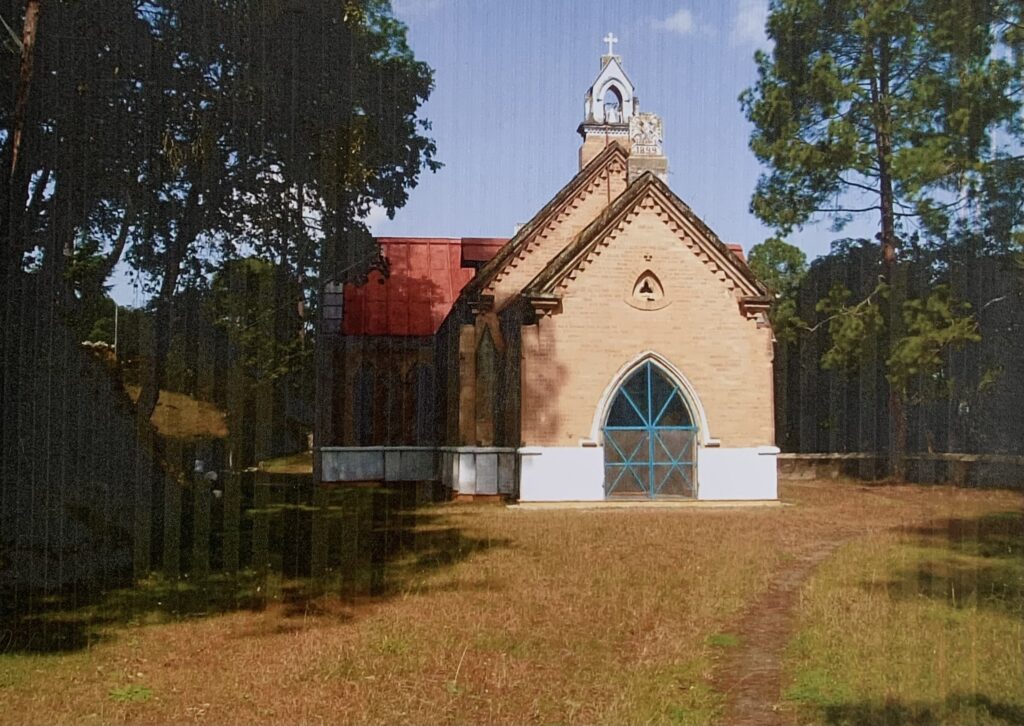
The Roman Catholic Chapel, Ranikhet, India. Photo, curtesy of Robin Butler our cousin, who we share a Great Grandfather with, John Pook RSM.
On the 1st November 1882 the 40th Regiment left Moradabad for a 672 mile route march across India to Peshawar in the hill country of the N.W. Province. They arrived at 5.30 pm on the 17th January, 1883. On the 6th May, 1883, the Regiment moved to Changla Gali, where John and Elizabeth’s first child Ellen was born. While in India Annie became friends with an Indian Begum (a Princess), who gave her a large carved make- up box engraved with mother of pearl which had numerous little compartments. Florenz Pook, Annie’s daughter, gave this box to her niece Christine Barry.
By 1883, when John was aged 30 years, he started to suffer from rheumatism. In June, 1884, the Regiment moved to Cherat, returning to Peshawar in July 1884.
During 1884 the Regiment left India, arriving in Aden on the 7th November 1884. John and Annie’s next child Florence was born in Aden (The Yemen) on the 27th July 1885. The Regiment left Aden on the 14th January, 1886, on the Royal Naval Troop Ship Crocodile.
After journeying through the Mediterranean they arrived at Portsmouth on the 3rd February, 1886. They had only been back in England for a week when their eldest daughter Ellen, aged 2 ½ years died on the 13th February 1886 after she caught measles, which she probably caught on the boat bringing them back to England from Aden. She is interred in Portsmouth Cemetery.
John Pook was awarded the George V Long Service and Good Conduct Medal & The George V Medal for Meritorious Service on the 26th April 1886. In 1887 Color Sergeant John Pook underwent a course of training at the School of Musketry, Hythe, and qualified for the appointment of “Sergeant Instructor in Musketry”. Eva Mildred Pook their third child was born on the 8th April 1887 in Portsmouth, Eva Mildred, our Grandmother to be, changed her name at some stage to Eva May, obviously the middle name Mildred did not sit right with her! On the 16th April, 1888, the Regiment moved to Leprine ?/ Liverpool?
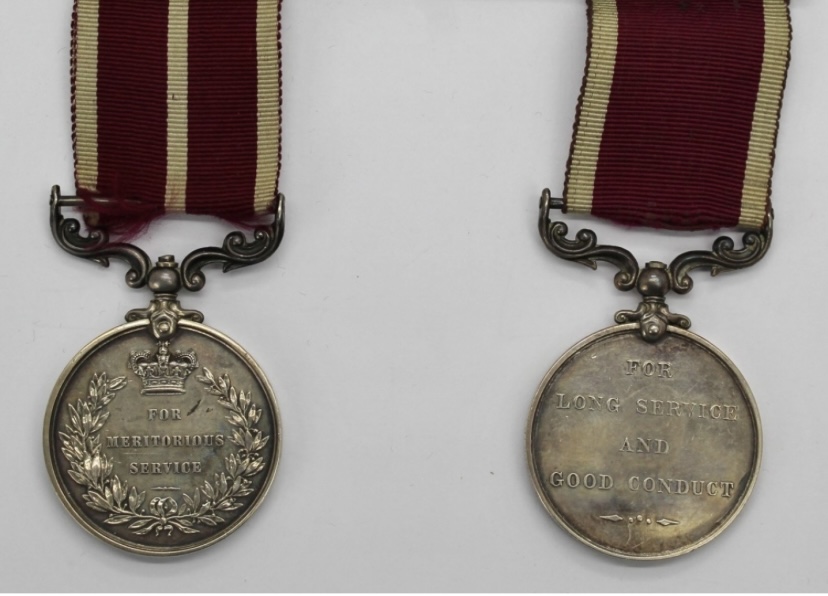
On the 2nd May, 1888, Drum Major Pook was promoted to Sergeant Major and appointed Warrant Officer. On the 31st May, 1889, the Regiment arrived at Portsdown Hill.
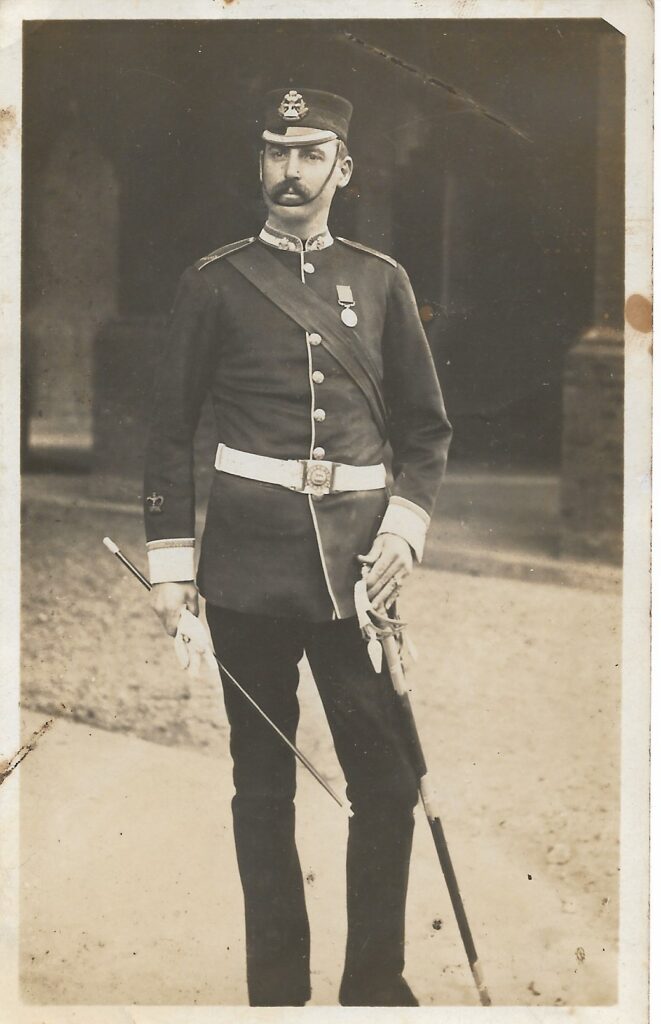
Esther Mildred Pook was born at Portsea Island in May 1889, but died at the age of 3 months from enteritis on the 20th of July 1889 at Fort Purbrook.
The Regiment’s next station was Fort Regent, St. Helier, Jersey in the Channel Islands, where they arrived on the 7th January 1890. Sergeant Major Pook was now R.S.M., and he had his quarters on the barrack square of the Fort, which was situated on a cliff high above the harbour.
John and Annie’s 5th child was born in the Channel Islands – Charles Henry Pook born in 1892 Jersey, in the Channel Islands. Died 22 January 1942 Dar es Salaam, Tanganyika, East Africa. More of Uncle Charlie later!

Pook family portrait probably taken in the mid 1890s. L to R – Eva May Pook ,(Our Grandmother), Florenz Emma Pook, (our Gt Aunt, John Pook, (Our Gt Grandfather), Charles Pook (our Gt Uncle) seated on his mother’s lap (probably) & Annie Elizabeth Pook, nee Sanderson, our Gt Grandmother. Photo probably taken in the Channel Isles.
In 1892 they were on the move again to Birr, Parsontown, County Offaly, Southern Ireland, arriving on the 12th September, 1892. The voyage from St. Helier to Dublin took three days. On embarking at St. Helier the family was assigned two cabins, but when it was reported to Sergeant Major Pook that the Master Tailor, by the name of Mullane, and his five children had no cabin, he gave up the larger cabin to the Mullane family. On arrival at Dublin, R.S.M. Pook left his family, together with the Mullane’s, at the Temperance Hotel, just outside Phoenix Park, Dublin, for three days while the Regiment settled in at Birr. To know more about the Pook family’s time while they were stationed with the Regiment in Ireland, our Gt Aunt Florenz Pook (Auntie Florry) records this in detail which I have included in Auntie Florry’s separate Post.
Sergeant Major John Pook left the Army on the 14th September 1893, while he was stationed at Birr, Eire; this was brought about by the damp climate that revived the rheumatism he contracted in India. This brought about his discharge to pension when he was 39 years of age. His height was then given as 5’ll”, complexion fresh, brown hair and hazel eyes. His Army No. was 2380. The family’s intended place of residence on John’s discharge papers from the army was given as 419 Strand, London.

The Barracks near Birr Ireland where the Pook family were stationed for several years. This view above was how it must have looked while they lived there.
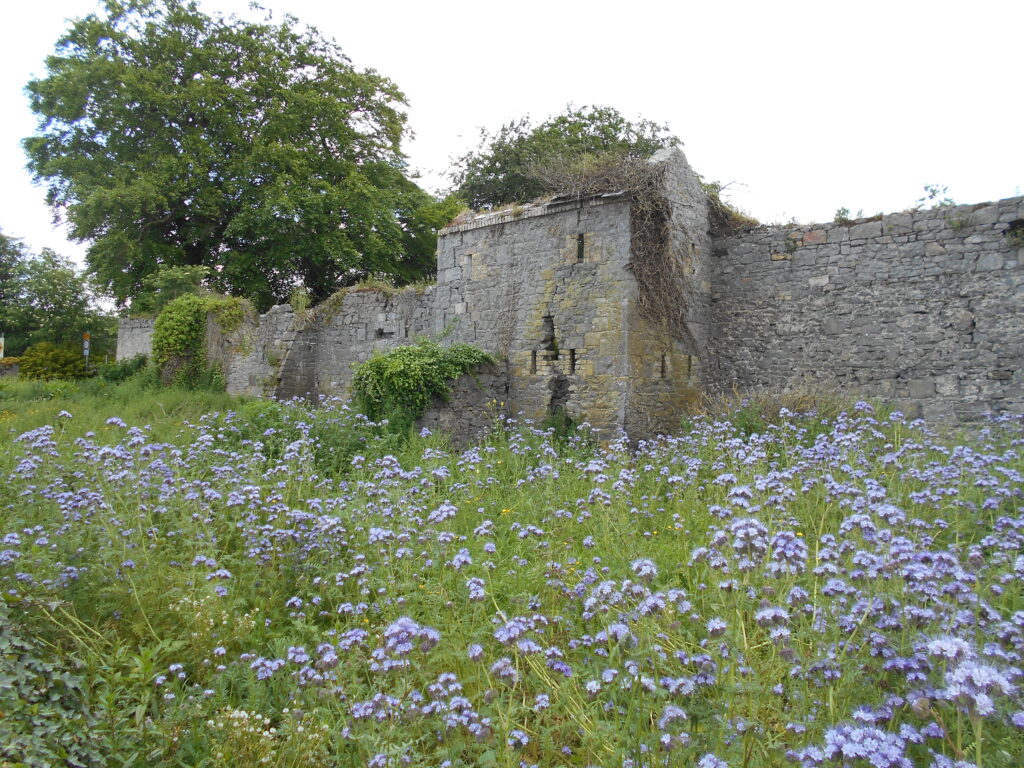
We visited Birr and the surrounding area in 2018. Most of the Barracks was destroyed during the troubles, apparently by the IRA. What does survive are large portions of the perimeter wall & some of the gateways.The photo above shows the general condition of the surviving parts of the wall.
William John Stephen Pook was born on the 29th September, 1894, at 2 Telford Avenue, Streatham, London, the year after his father had come out of the Army. He died on the 22nd February 1958 and was cremated at Barham Crematorium. I will feature William’s life in detail later. John Pook is employed as a builder’s clerk. Six years later in 1900, the family have moved and are living at 112 Alfred Terrace, Fleetwood, Lancashire. John is now employed as a public school steward at a large Public school by the name of Russel School.
Their last child,( & sadly the first member of the family to die) Dorothy Helena Pook was born on the 6th June, 1900, at 12 Alfred Terrace, Fleetwood, Lancs. She died on Christmas day 1927 in Wimbledon; London aged 27 years and is buried close to her parents in Wandsworth Cemetery. She was called Doll and adored shoes. She never married and worked as a clerk. Dorothy was Godmother to her sister Eva’s daughter, Muriel Butler. She contracted Pulmonary Tuberculosis and died at 43 Southdean Gardens, Southfields, London, on Christmas Day, 1927, at the age of 27 years. In the months before she died, she was said to have had a “vision” of God and the Holy Spirit causing her to die in sanctity.
She has a beautiful white marble monument of an angel carrying a trumpet over her grave in the Catholic portion of Wandsworth Cemetery at Magdalen Road, Wandsworth, which her sister Florenz had carved in Italy and brought over to England. The family thought a lot of her, although her sister Eva did wonder whether her vision was caused by her illness.
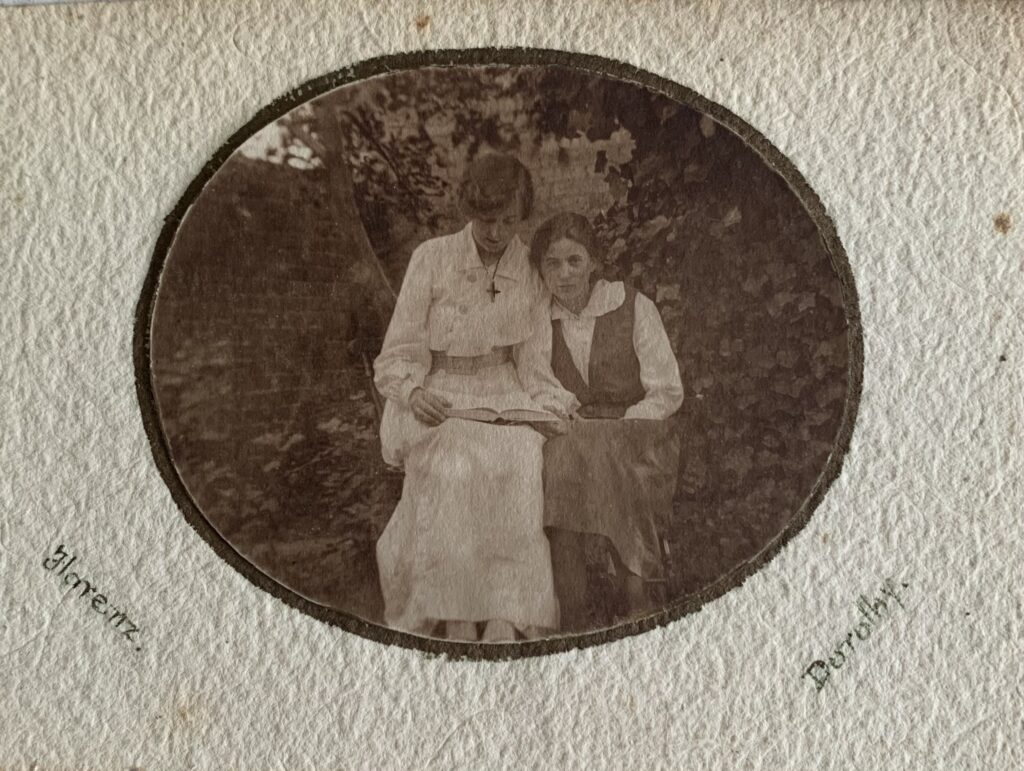
The portrait photo above of Florenz Pook & her little sister Dorothy Helena was probably taken post WW1.

The Barry’s finally visited their Gt Aunts grave in Wandsworth Cemetery near to where the Pooks used to live. We managed to visit the cemetery in 2013, despite the snow & have maintained this striking grave along with our Gt Grandparents grave which is adjacent to Dorothy Helena Pook’s striking Angel Monument/Grave.
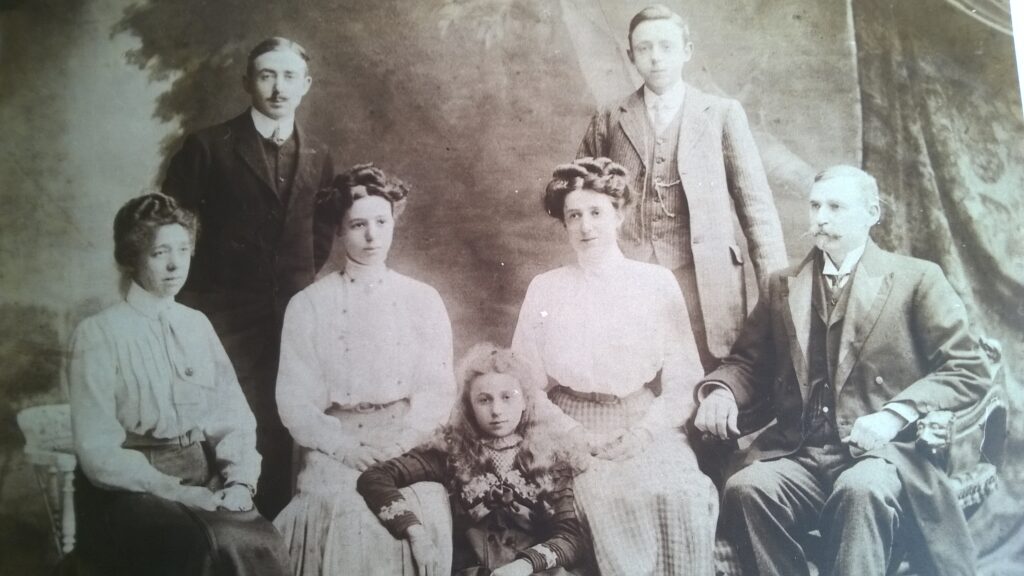
Great Grandparents Pook, and Grandmother Pook & family, picture taken about 1913. Photo probably taken in the Medway Towns.
L to R – seated- Great Grandmother Annie Elizabeth Pook (nee Sanderson) b 27 July 1864 – d 07 Feb 1938. Grandmother Eva May Pook b 1887 – d 05 Nov 1965, Great Aunt Dorothy Helena Pook b 1900 – d 25 Dec 1927, Great Aunt Florenz Emma Pook b 27 Jul 1885 – d 13 Sep 1974, Great Grandfather John Pook b 1854 – d 05 Nov 1932
Back row standing L to R- Great Uncle Charles Henry Pook D.C.M. b 10 Feb 1892 –, d 22 Jan 1942 – Great Uncle William John Pook b 1894 – d 1957.
By 1911 John and Annie have moved again and are now living at 40 Rochester Terrace, Chatham with just two of their daughters, Eva and Dorothy. Also with them on this Census night was John Pook’s brother-in-law Richard James Sanderson, he was a soldier on leave. John is now employed as a Clerk, Army Pay Office.
On the 20th February 1924, Warrant Officer John Pook is awarded the George V Medal for Meritorious Service, which entitled him to an Annuity of ten pounds from the 19th November 1923. John and Annie Pook had retired by 1927 and were living at 43 Southdean Gardens, Southfields, Wimbledon, London, SW19, in the Borough of Wandsworth.
In 1928, when the 1st Battalion carried out the Public Duties in London, the alert, erect and soldierly figure of the late veteran was a familiar sight in Chelsea Barracks. At the Cenotaph Parade on September 16th, he was the oldest soldier present, but carried his years lightly and with becoming dignity.
John and Annie’s single daughter Florenz lived with her parents and looked after them in their old age. Warrant officer John Pook died in London on the 5th November 1932 aged 78 years and is buried in Wandsworth Cemetery, Magdalen Road, Wandsworth, London. Grave space No 222, Class G, Block 24 in the Catholic portion. His grave is very near to that of his daughter Dorothy Helena. Annie Elizabeth Pook, John Pook’s wife died on the 7th February 1938, aged 73 and is buried with her husband John Pook in Wandsworth Cemetery London.
At some stage in about 1958 when she had retired for a while, Florry decided to sell the Wimbledon house and move to Sittingbourne where her sister Eva lived, and she bought a small bungalow at 89, College Road, Sittingbourne. She was a very independent lady, and never quite lost her school-teacher touch, and made the most superb maple candy.
Charles Henry Pook born in St Heliers in the island of Jersey, Channel Isles, on February 10, 1892. Died 22 January 1942 Dar es Salaam, Tanganyika, East Africa. (Our Great Uncle)
The 1911 Census, records that Charles Pook aged 20 was at Stanhope Lines Aldershot, Hampshire, in Barracks. His profession was recorded as Telegraph Linesman with the rank of Sapper in the Royal Engineers.
He was a full time professional soldier before the First World War, Sgt. Charles Pook 16026 (D.C.M.), Royal Engineers, G Cable Section. He was on active service during the 1st World War, arriving in France on the 14th August, 1914, and fought at the Battle of Mons.Years later Charles Pook, while living and working in Tanganyika in Africa decided to write up his wartime experience at the famous Battle of Mons during WW1. He had it published in the Journal of Tanganyika European Civil Servants Association, of which i presume he belonged to.
He sent a copy of this article, which appears below, to his older sister Florenz Pook, Auntie Florry.
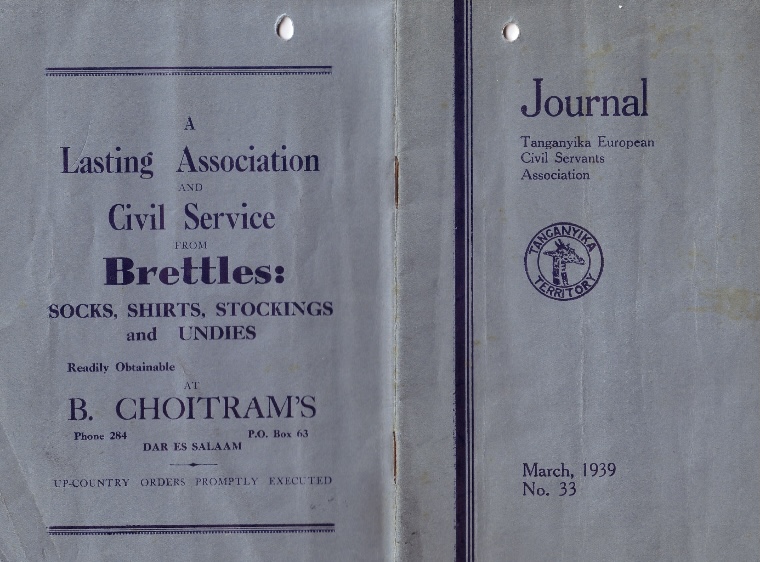



Auntie Florry writes about her brother Charles Pook as follows –
During 1920/21 – “We set out from Lille by train to visit Ypres where my elder brother fought during all the battles for Ypres and was present at the funeral of the Prince (Imperial) and who was given full military honours at his burial in the face of the fierce onslaught going on. We saw his tomb in the small churchyard just outside the Menin Gates.”
The Prince Imperial, Prince Maurice of Battenberg was the youngest Grandchild of Queen Victoria. He was killed in action on 27.10.1914 & buried in Ypres on 31.10.1914
“My older brother told me of once during 1915 he and a couple of other R.E.’s had to shelter from a terrific bombardment in one of these shell holes whilst out on their telephone repairs and far from their unit – the shells were so continuous that they had to shelter for two days with only one bar of chocolate which my brother happened to have and shared with the others. Hunger drove them out and one night they crept out to try and find food. They came to a farm but at first the occupants who were in the cellar would not reply to their knocking – thinking they were Germans – but at length they realised it was English voices and they admitted them and gave them help.”
Charles was awarded the Distinguished Conduct Medal, which was mentioned in the London Gazette on the 11th April 1918. The Distinguished Conduct Medal was awarded to Lance-Corporal (A/Sergeant) C.H.Pook, 74th D.N. Signal Company,Royal Engineers, for conspicuous gallantry and devotion to duty on the 6th November 1917 during the Battle of Passchendaele also known as the Third Battle of Ypres.
The Citation below for Charles Pook’s DCM was printed in The London Gazette in 1918
“For conspicous gallantry and devotion to duty. Whilst laying cable to advanced brigade report centre, his party came under shell and rifle fire. Placing his wagon under cover, he then proceeded to lay by hand. On his arrival at the report centre, hearing that the objective being attacked had been captured he volunteered to lay cable to this point and accomplished his task. Throughout the action his courage and cheerfulness inspired all ranks in the highest degree”.
We know that Charles Pook served throughout the entirety of the First World War, and it seems that for the majority of this time he did serve in Belgium and France. His sister Florry mentions in her reminiscences that, “and my two brothers safely home from their four years in the trenches of France, and the battle area of Palestine under Hilenly (Allenby) I decided to visit some of the Battlefields of N. France where my brothers had fought, one in the Royal Engineers (awarded D.C.M.) a regular soldier and the other a territorial in the Machine Gun Corps 18 yrs of age when sent to the front trenches.” There is also a brief mention of Charles Pook in his father’s Regimental magazine dated 1928 in an article mainly about his fathers service. It states at the end, “his son who served in the R.E. throughout hostilities and was decorated at Jerusalem.” – What “decorated at Jerusalem” means I do not know?
I have not yet been able to find Charles Pook’s official record of his service during WW1. We have been able to piece together much of his service by way of his written record, anecdotes relayed to his family, medal records and a few photographs. We were uncertain of his service in the Middle East until we discovered in 2022, a loosely contained photograph/ Postcard within the Pook/ Sanderson Photo album dating from the 1800s onwards, the post card below seems to indicate that Charlie Pook did serve in the Middle East at some time either during or after WW1

We are presuming that this Postcard was written by Charlie Pook while in the Middle East, the hand writing matches his, based on the samples we have of his hand writing. The “C” and the x must refer to him. The uniforms of the squad of soldiers in this picture are typical of the Royal Engineers.
I inherited Charles Pook’s copy of the “Rubaiyat of Omar Khayyam” which I believe has his own inscription on the flyleaf, this also indicates that he probably served in the Middle East. A copy of the inscription and the front cover of this book appears below.
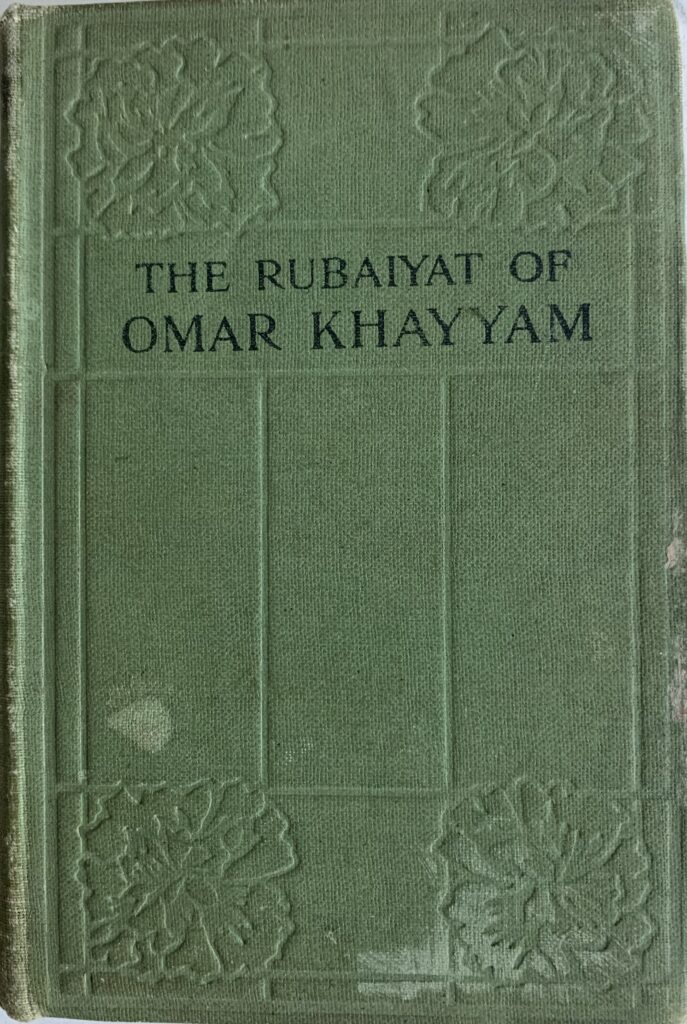
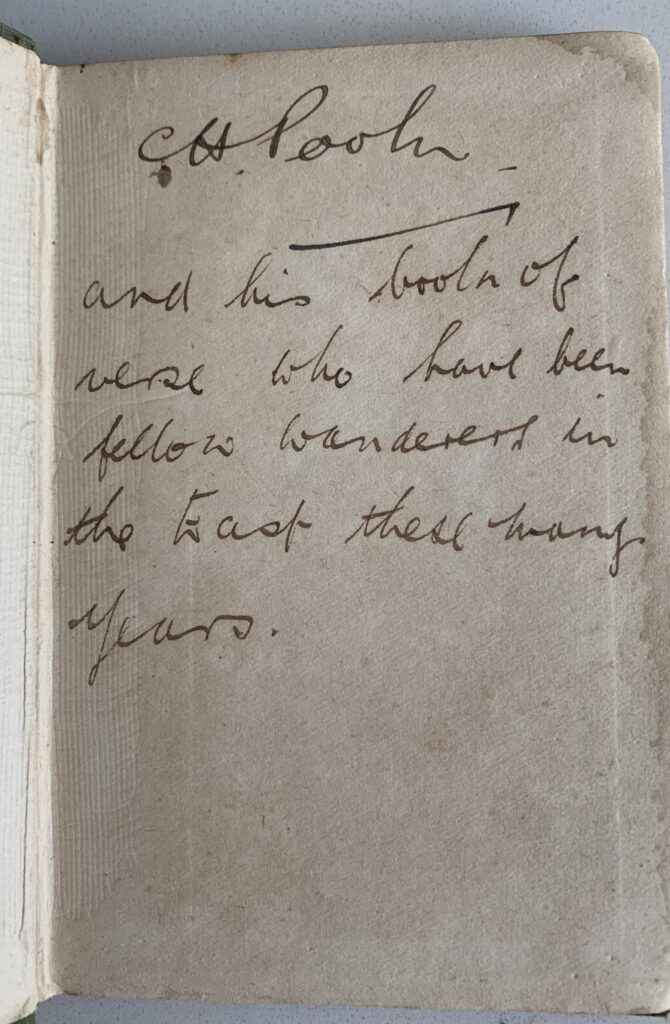
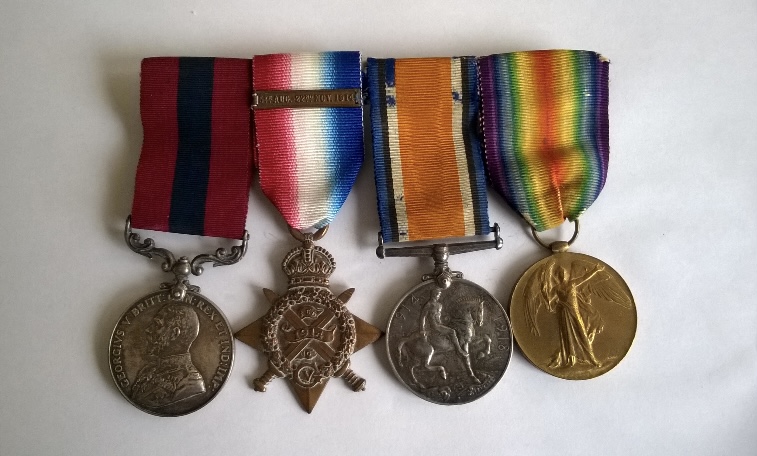
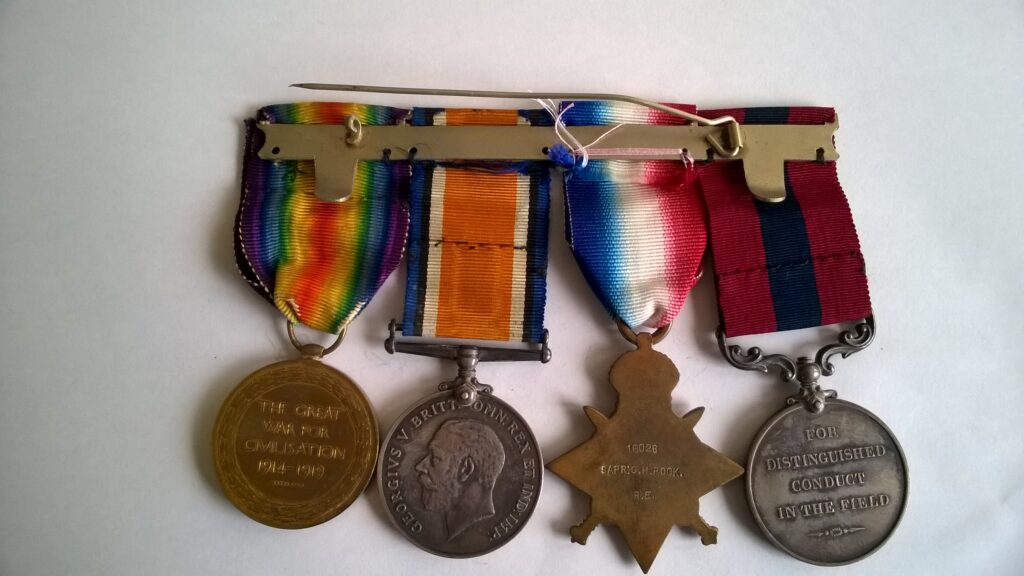
The photos above are of Charles Pook’s WW1 Medals, & the photos below are the official British Army Medal Index cards 1914 – 1920 concerning his Medal Entitlement record etc.
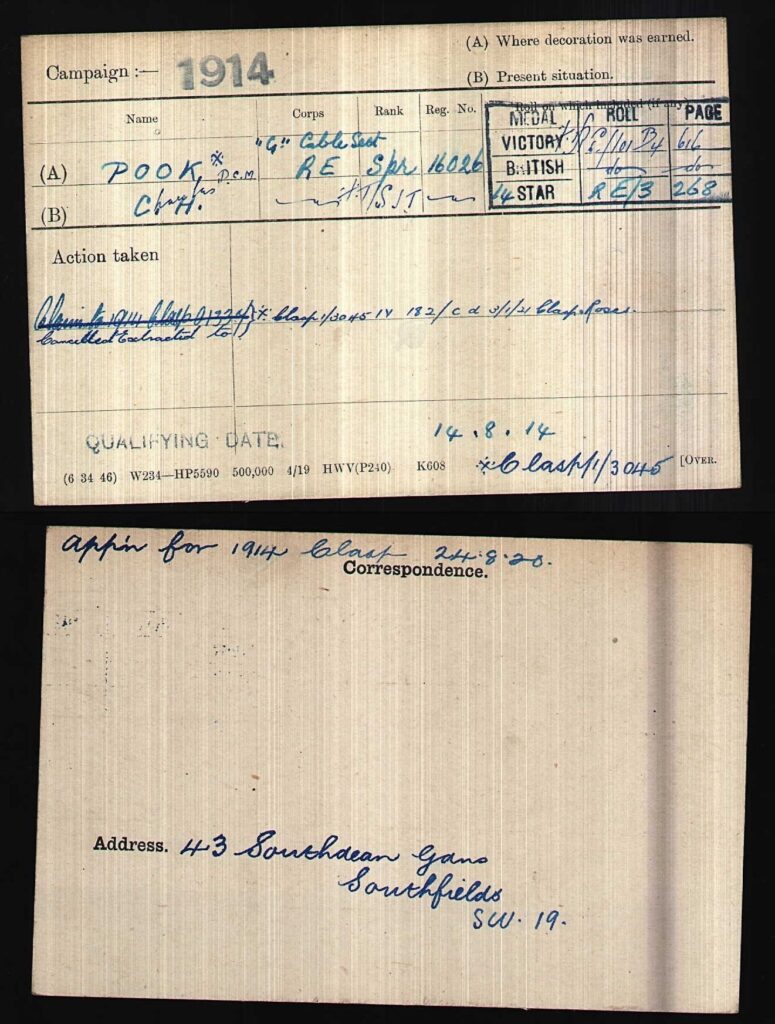


The Photograph above, taken post WW1. Left to Right. Our Great Grandfather John Pook. His son, our Gt Uncle, William Pook, Machine Gun Corps WW1. Williams older brother, Charles Pook D.C.M. Royal Engineers WW1. Photo probably taken in the Medway Towns.
Charlie Pook was great friends with his cousin, Charlie Sanderson. (More about him in the future!) and on the Sanderson Post.
Charles Pook was appointed to the Tanganyika Posts and Telegraphs Department in August 1920, arriving there in September to take up his duties as a Telegraphs Inspector at Sadani. He was also stationed at Bagamoyo, Dar es Salaam, Tabora and Tanga, in addition to a period at Mombasa in 1935. On Saturday, 27th July, 1935, Eric Butler (Eva Pook’s son) notes in his diary that Uncle Charlie and Aunty Daisy visited (i.e. 116 East Street, Sittingbourne) from Southend. They must have been in England on one of their many visits home to visit family.
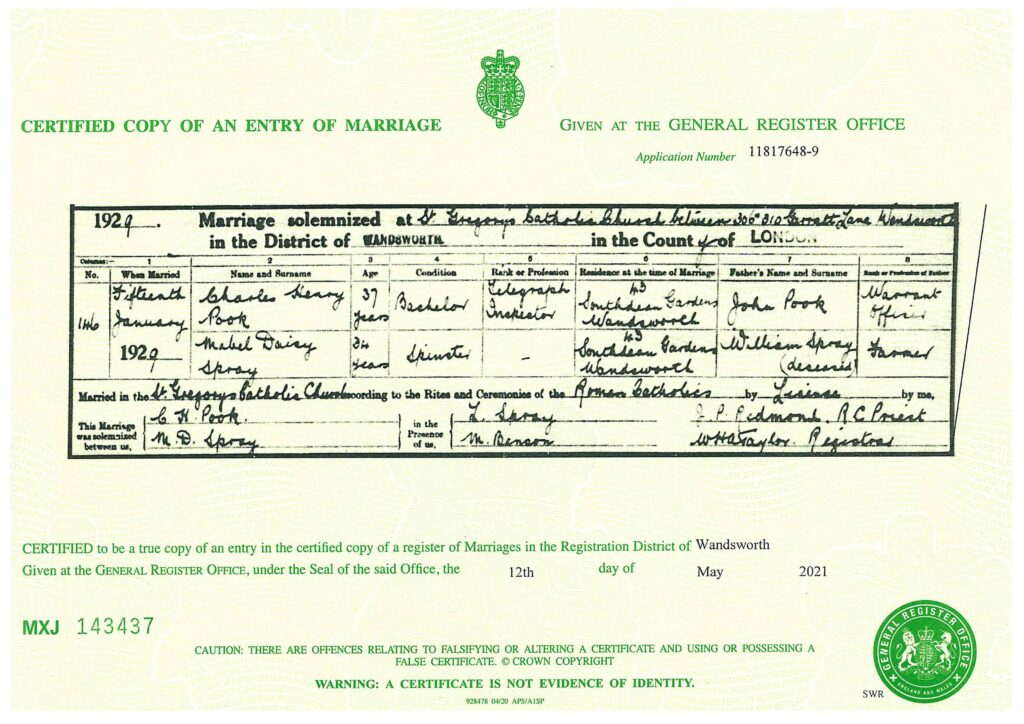
Charles Henry Pook married Mabel Daisy Spray on the 15th January 1929, his wife was known as Daisy, they had no children. I always thought that she had a marvelous sounding maiden name “Daisy Spray”
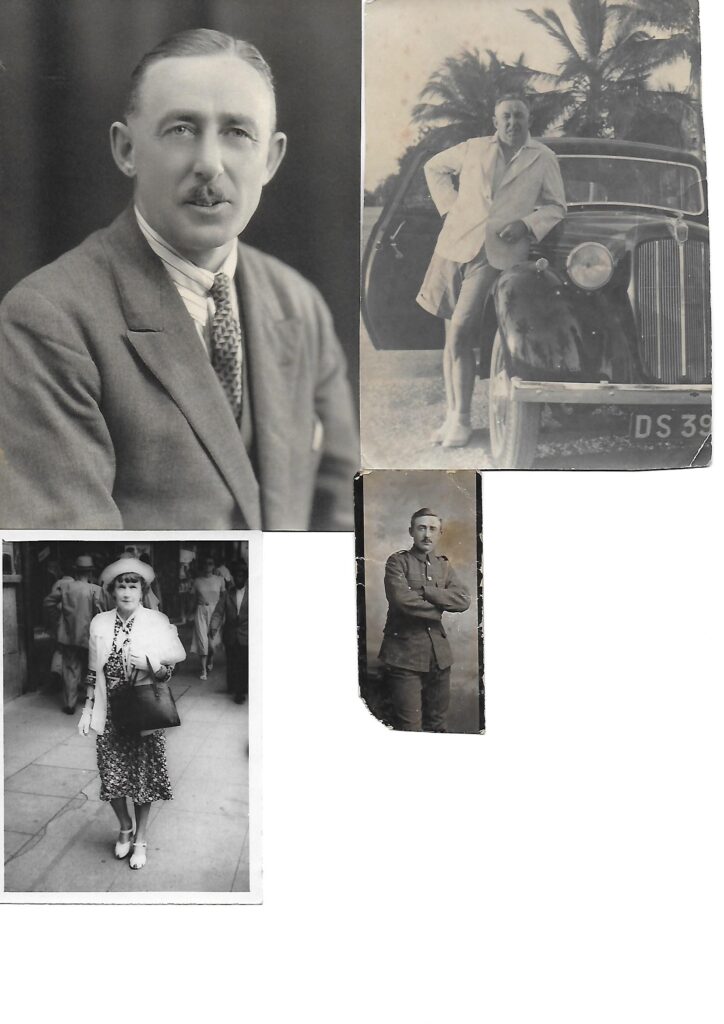
Key to photos above. Top Left, portrait of Charles Pook likely taken post WW1. Top Right photo of Charles Pook taken in Tanganyika 1930s/1940s. Bottom left Photo, Mabel Daisy Spray, nee Pook, probably taken in the UK during the 1930s. Bottom right photo is of Charles Pook in R.E. Uniform likely taken during WW1.
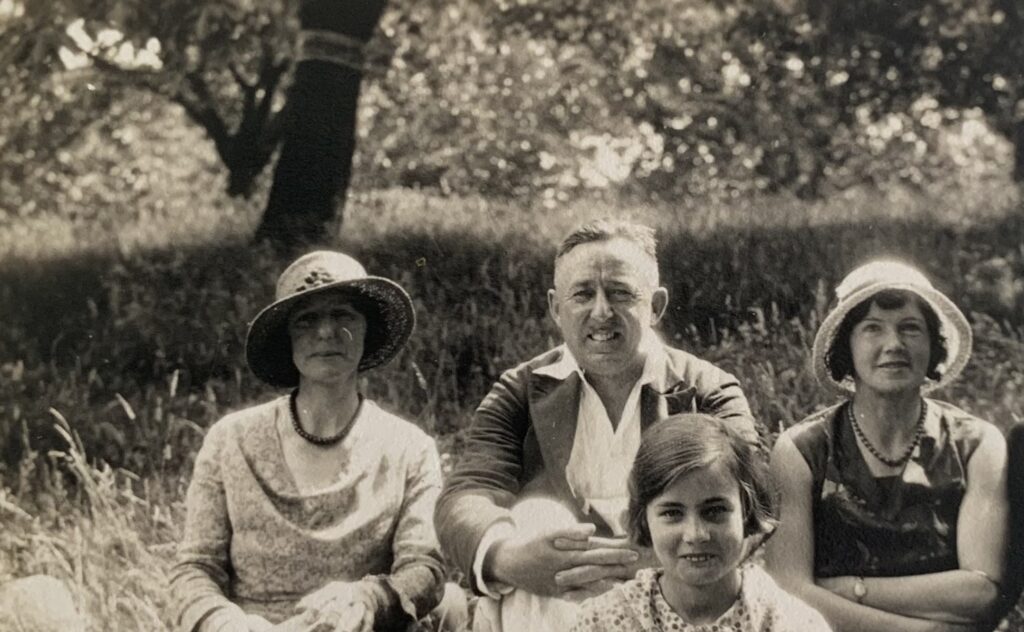
Key to photo above, Left to Right. Our Grandmother Eva May Pook, nee Butler. Her brother Charles Henry Pook, his wife Mabel Daisy Spray, nee Pook. Our mother, Muriel Dorothy Butler is sitting centre foreground of this photo.
This photo was probably taken on one of at least 5 trips home that Charlie Pook & his wife Daisy made from Tanganyika in Africa where Charlie worked as an Inspector of Telegraphs.

The Passenger list above is dated 10th February 1932, this was when Charles Pook & his wife Daisy arrived back in the U.K. from Africa. Just one of many trips that they made back from Africa where Charles Pook worked.
He was a staunch member of the Dar es Salaam Gymkhana Club, the Railway Club and the British Legion (Tanganyika branch). Tanganyika (now Tanzania) is in East Africa. He used to go out big game-hunting, (and smaller, little game!) and sent back some of the skins mainly leopard and hyrax (Coney). Florenz Pook had the hyrax skins made into a coat, and after she died her great-niece Patricia Butler had the coat cleaned and restyled.
I am fairly sure that all the Butler and Barry Great nieces and nephews played at being Leopards when wearing these skins and other games. I am fortunate that I inherited one of these skins! Charlie also shot at least 1 Kudu! The Horns adorned his sister’s house for many years. I inherited, and then renovated the famous Kudu horns, they have moved house with me several times and are now currently on display on an internal wall of my garage.
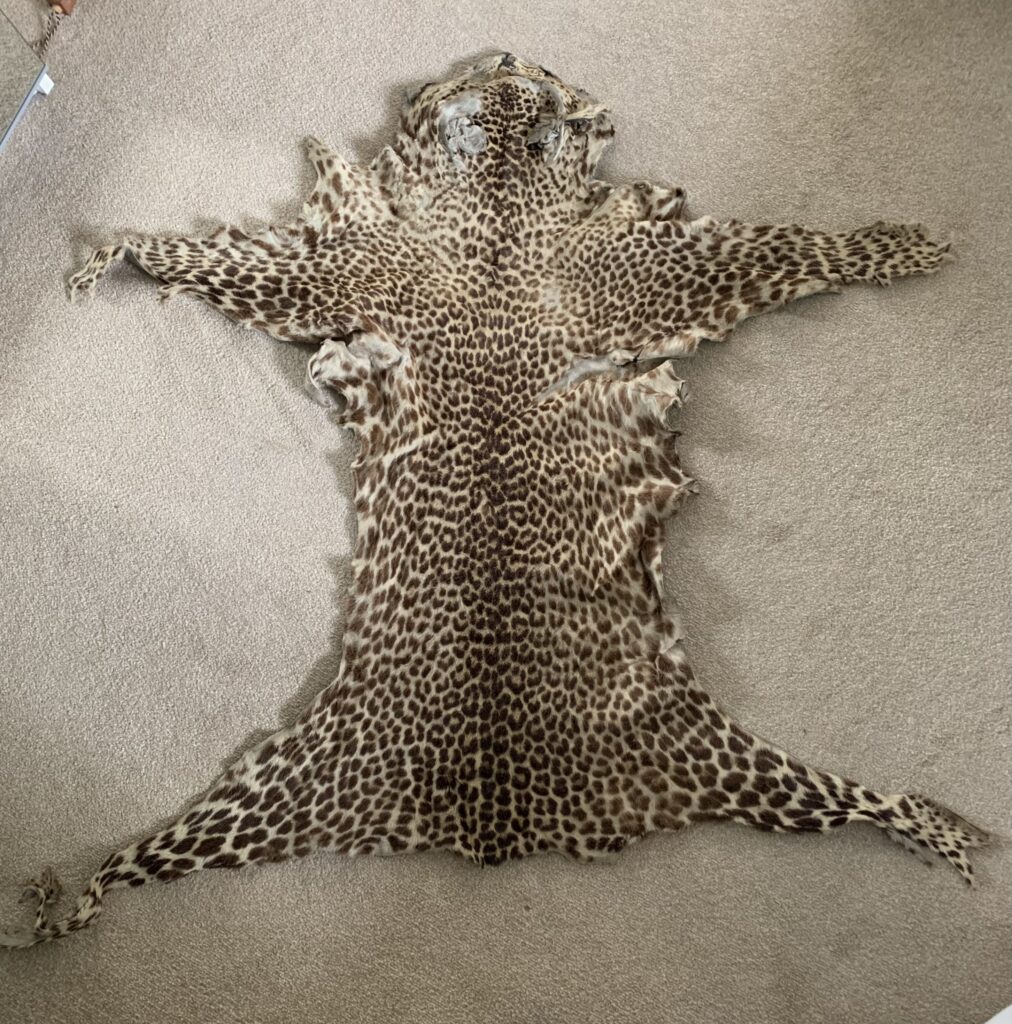
This Leopard skin from Gt Uncle Charlie was on show at 181 for many years. Do not know when the tail got detached, but probably through boisterous play. I know at one stage it adorned my bush hat, it circled the crown of my bush hat perfectly! No idea where the tail is today!

Above are the famous Kudu horns, (cherished by me!)

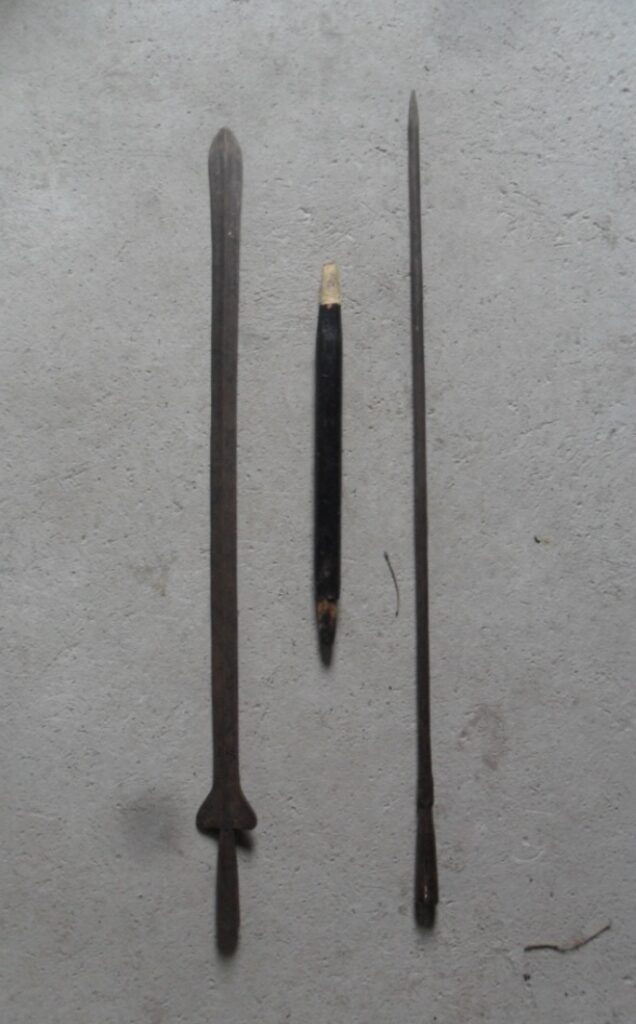

Not sure if this large Brass Bowl with Elephant Head handles originated from Africa or India. All I can say is that it was in Aunty Florry’s possession before it came to me. On further research similar brass bowls are described as “Anglo – Indian brass Jardiniere.
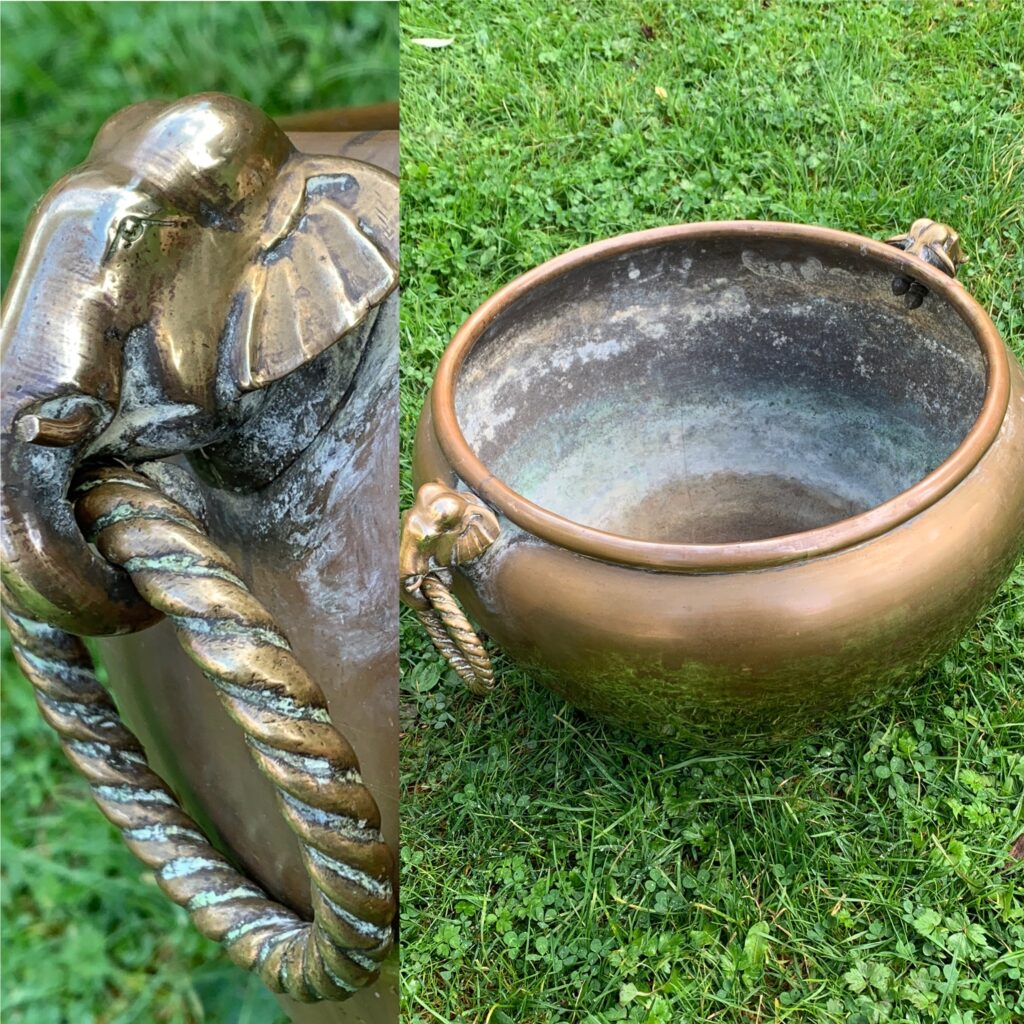
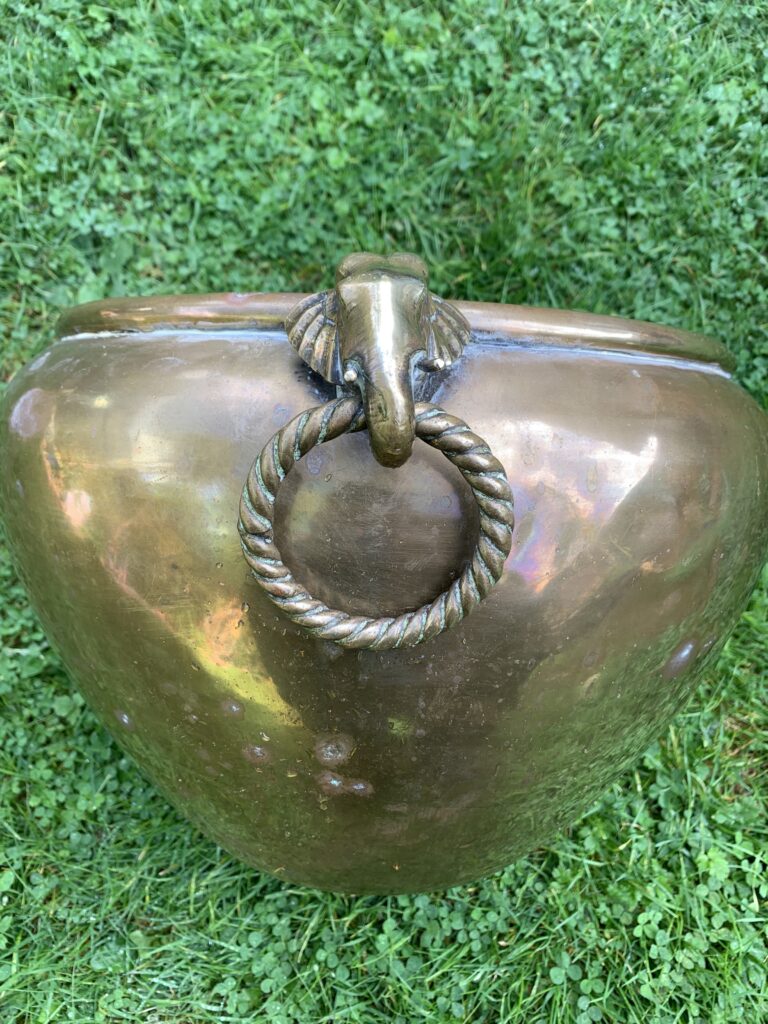
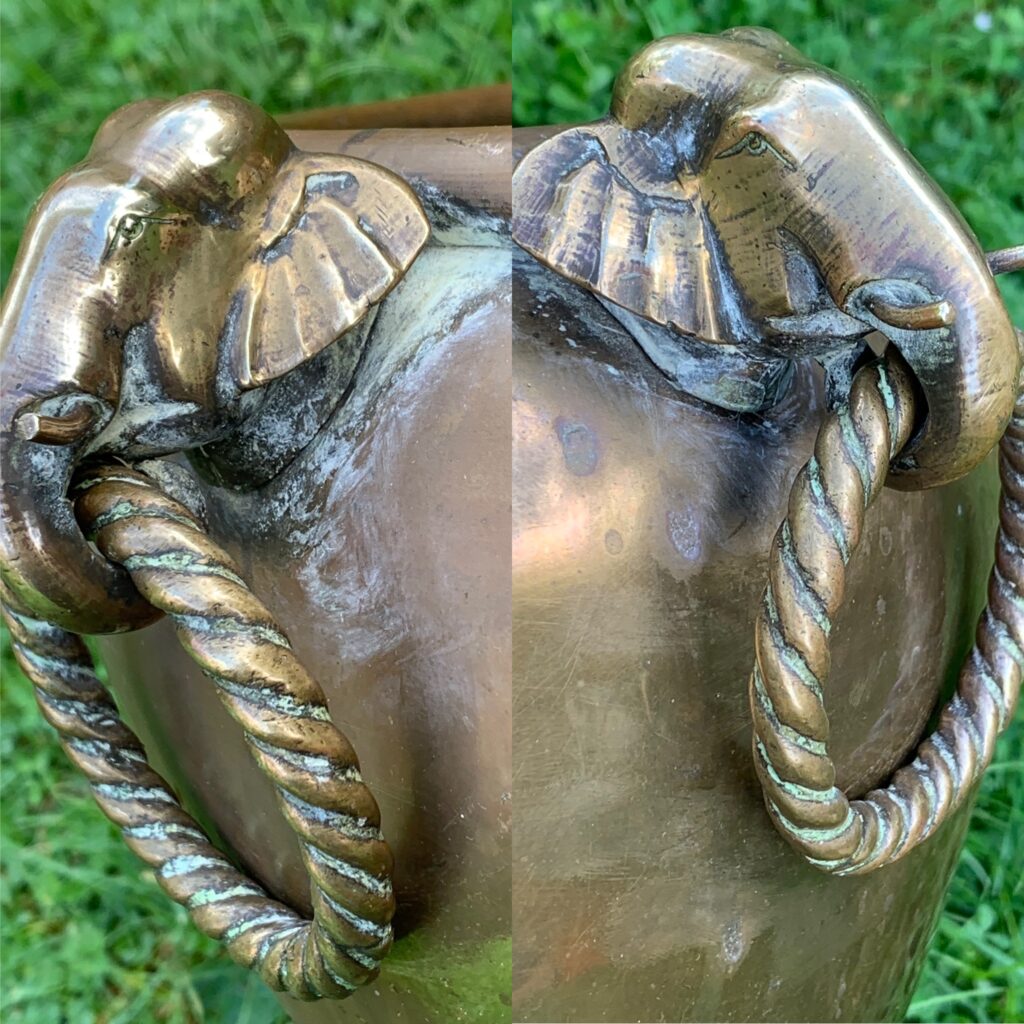
Charles died in the European Hospital, Dar es Salaam, Tanganyika, East Africa on the 22nd January, 1942, as a result of heart trouble following an operation for acute appendicitis. He did not regain consciousness.
He was 50 years old. He was working hard trying to get his work up to date, ignoring his pains, and left it too late. He was buried at the New Cemetery, Dar es Salaam. His wife Daisy remained in Africa.

The Photo above was taken of Charlie by his wife Daisy in Tanganyika, probably fairly close to the time he died in 1942.
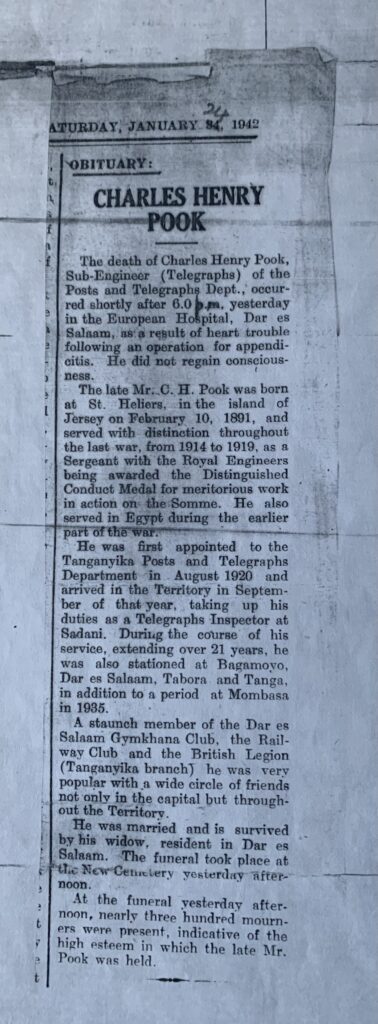
I believe the copy of the newspaper cutting above was from a local paper in Tanganyika.
Uncle Charlie and the crocodile
This is one of many stories that I (Kevin James Barry) remember being told by Auntie Florrie (Auntie Tusi-Tala) on at least one occasion and probably more as the details are still clear in my memory approximately sixty years later.
Great Uncle Charlie was working in Tanganyika in Africa and one day while he was out in the bush, a party of local tribesmen (the headman) visited his camp and said “Bwana, a great crocodile is menacing our village and is attacking and eating our children when they go down to the river to bathe, please come and shoot this beast with your rifle”
So Great Uncle Charlie went along with the tribe’s people/headman to their village where he inspected the site of the attacks and of the river and decided to attempt to shoot the crocodile. He hung up a piece of meat on a tripod near to the river to attract the crocodile and then lay in hiding with his rifle and waited……
Finally, his waiting paid off as a huge crocodile came slowly out of the river and approached the bait. As the crocodile stretched out its mouth to the meat, Uncle Charlie took aim and shot his rifle at the crocodile. To his horror, the crocodile gave a great leap up into the air towards him. Uncle Charlie dropped his rifle and ran away into the bush.
When he had recovered his wits (and found that the crocodile was not chasing him) he returned cautiously to the river and there discovered the tribe’s people carrying the huge crocodile on a wooden pole back to the village to cut up for meat. That evening when Uncle Charlie visited the village he was thanked by the chief who presented him with a large amount of butter as a thank-you.
Apparently, he had been accurate with his shooting and the leap of the crocodile was its death leap and not an attack on Uncle Charlie.
Kevin Barry 2023
William John Stephen Pook, born 29th September 1894 London, died 22nd February 1958. (Brother to Charles Pook)
William John Stephen Pook was born on the 29th September, 1894, at 2 Telford Avenue, Streatham, London, the year after his father had come out of the Army. He died on the 22nd February 1958 and was cremated at Barham Crematorium.
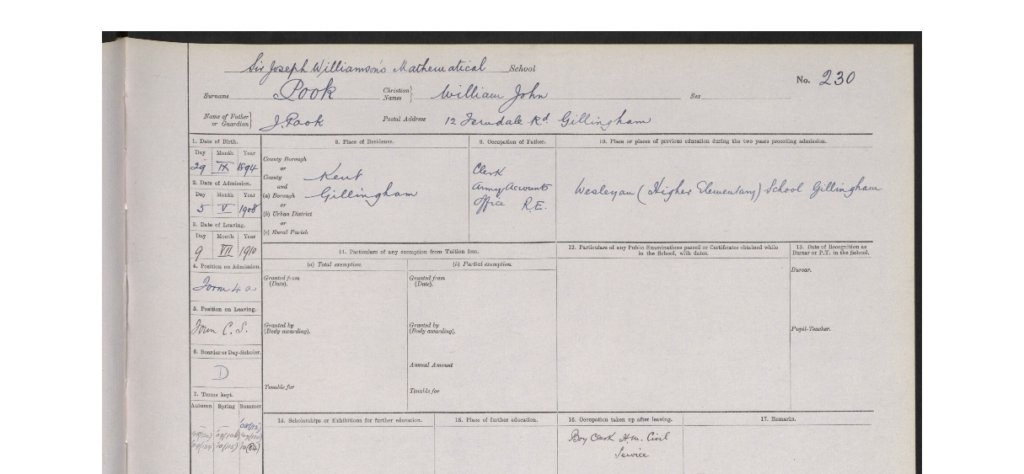
William Pook attended the Wesleyan Higher Elementary School in Gillingham, and went on to the Joseph Williamson Mathematical school from 1908-1910. Grammar School
As far as we can tell, Binkie, Gt Uncle William Pook joined the Prince of Wales’ Own Civil Service Rifles first as a boy cadet and then as a Territorial Soldier when he began work in the Civil Service as an adult. He would then have become a member of the Civil Service Battalion (15th County of London Battalion) London Regiment. I would imagine he was very proud to be part of this regiment. According to the census of 1911 when William was 16 he was working in the War Office – Civil Service Commission as a Civil Servant.
He was 20 years of age when War broke out, and he would have been a fully trained soldier.
He was nicknamed “Binkie” and was very tall. He was also quite dark skinned. Sgt. William Pook was in the 15th Bn London Regiment, and then transferred to the Machine Gun Corps 1449 (23433 23453). William fought in the 1st World War arriving in France on the 17th March 1915. He was awarded the George V Territorial Efficiency Medal (TEM) on Army Order 299 of 1923. The medal was issued on the 23rd October 1923. He was Disembodied (a term for demobilisation of a Territorial soldier) on the 26.3.1919?
Men of the MGC specialy trained in the operation of the Vickers light automatic machine gun, were always deployed on the front line of the battlefield, sometimes even ahead of it in no man’s land, and sitting targets for every weapon that the enemy could throw at them, so much so that members were sometimes known as the suicide club. Casualties inevitably were enormous. Of the 170,000 officers and men who served in the MGC, 62,000 became casualties, (over 36 %) of these nearly 14,000 were killed, and a further 48,000 were wounded, missing or became prisoners of war.
William J Pook (Binkie) was extremely lucky to be one of the survivors.
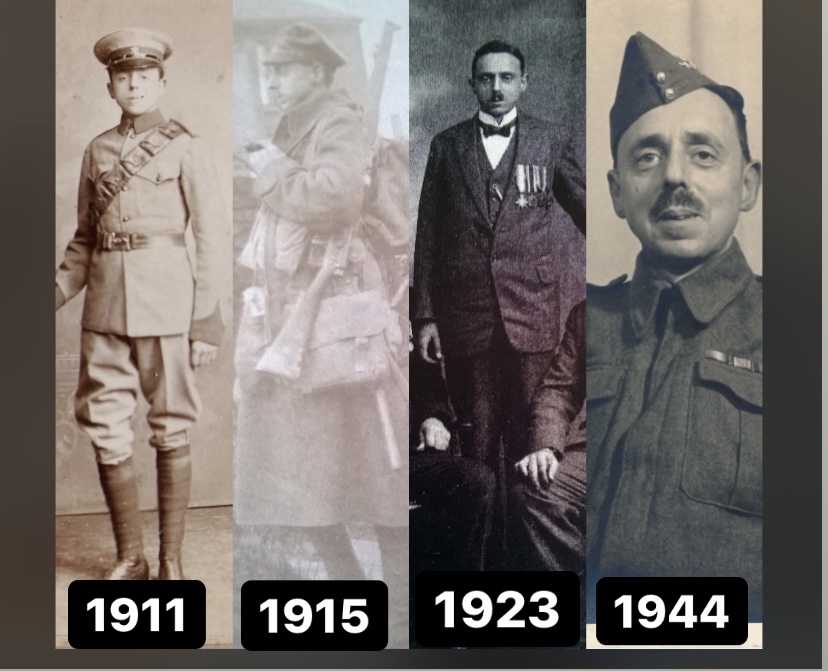
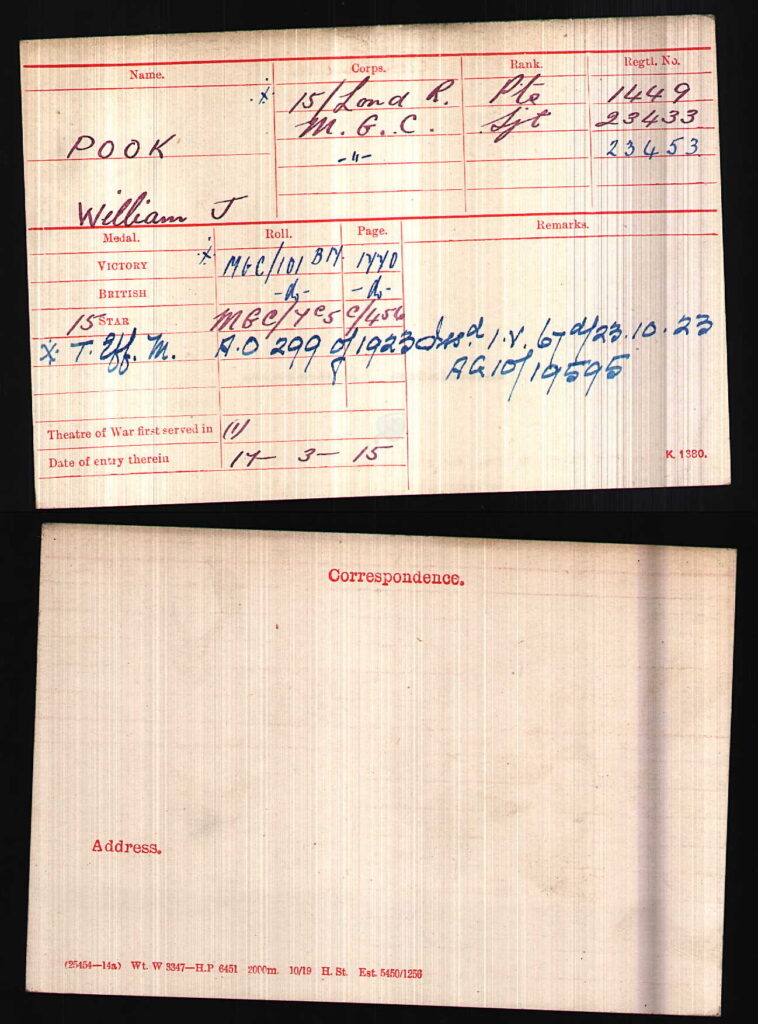
The photo above is the official British Army Medal Index cards 1914 – 1920 concerning his Medal Entitlement record etc.
The piece below is what Auntie Florry wrote concerning her two brothers during WW1, William, MGC, & Charlie RE.
Through The Battlefields of N. France (1914-1918 war)
In 1920-21, having passed through the 1st World War in my house in Wimbledon Park and my two brothers safely home from their four years in the trenches of France, and the battle area of Palestine under Allenby I decided to visit some of the Battlefields of N. France where my brothers had fought, one in the Royal Engineers (awarded D.C.M.) a regular soldier and the other a territorial in the Machine Gun Corps 18 yrs of age when sent to the front trenches. (William Pook, Binkie)
I contacted a friend from Jersey who wished to accompany me – so we set forth on a day at the end of July – my younger brother having given me the names of several areas to visit and also the addresses of two or three of his billets. . (William)
We arrived in Calais, still showing much of the destruction and from there we were able to get trains to Bethune – Vimy – Armentieres and other places. N. France was still in a state of destruction but the streets had been cleared of rubble.
We found Bethune absolutely wiped out – not a house standing – gaping cellars with bedsteads still there where the inhabitants had taken refuge during the bombardment – just as we where to do later in 1939- 1945. At one spot – strange to say – the only thing left of a house was the front garden iron gate.
I sent my brothers, now home , a P.C. showing Bethune in this state and to my surprise and wonder they sent me a coloured P.C. of Bethune as it was before the bombardment – and saying “This is Bethune as we first saw it”. How one of them still kept that P.C. I never knew – as he must have bought it when first in that town.
We went on to Leus and Loos – still under clearance and from there we made a pilgrimage to Vimy Ridge – a sad day – as some of the trenches were still left as the last soldier left and various pieces of equipment were still to be seen. Just below the ridge there was a small cemetery where many Canadian soldiers were buried and my friend and I picked bunches of poppies, marguerites and cornflowers – growing wild in profusion close by – and placed them on some of the lonely graves so far from their nearest and dearest
Later on we made our way to one of the Billets where my younger brother had been. A country place near Choque – the final stage of our journey there had to be taken in a small train used only by the miners and there we were seated with all the miners on their way to the mines. We then had to walk about a mile to reach the village and the house of the village school mistress – who was most kind to us. From here we walked several kilometres to Breay – another mining town – to visit friends of my brother where he had been billeted. Unfortunately, when we arrived there no-one was at home, so we trudged back again, arriving foot sore and tired.
The following day to our great surprise, these French friends – the father Mous Coutirer and Berthe the daughter arrived – having learnt from neighbours of our visit the previous day – they were so concerned at not being in when we arrived – that they walked all those kilometres to see us and persuade us to come again and stay for a few days. we at length agreed, but only if we could find a conveyance of some sort – a difficulty as it was harvest time and all horses were needed in the fields. At length a young man offered his trap and a poor old nag to take us to Bruay, there was no other way of getting there – no taxis or cars.
These friends of my brothers were most kind and treated us well. There was very little of interest to be seen in this mining town, alike to all mining districts with streams of water flowing through the streets.
The next thing to do was to find the Rue du Desert where the Convent was situated. We had to go over a temporary foot bridge over the river which flows through the town and which my elder brother told me later was erected by the R. Engineers when he was there – in place of the one destroyed by the Germans. We found the Convent and were greeted with great warmth by the nuns who used to teach us. They showed us an inside wall where they had bricked up all their valuables sacred vessels from the vandalism of the Germans – who they said – went round time and time again tapping the walls to find the hiding place – but all to no avail. The first armies of Germans they said were quite reasonable and damaged nothing in the Convent, but the remnants that passed through in their retreat were an altogether rough type.
They took over a model house the nuns had in their garden used for training their girls in house-keeping. A fully furnished house where the girls took their turn in being the Mistress of her house and then a maid in the house. This model house was left in a most disreputable state and after the Germans had finally retreated the nuns had to remove everything in that house and leave it completely empty – as we saw it then – before they could make it habitable again.
We noticed a long flight of steps in the garden at the top of which was a summer house overlooking the high wall surrounding the garden. We remarked on this and the nuns told us it was build at the orders of a German Officer who wanted a vantage point over the wall.
Strangely enough, on relating my visit to my younger brother on my return home, he said he had been billeted in that very Convent during the War – not knowing that his two sisters were well known by some of the nuns.
We ended our visits to the battlefields and returned to Paris where we spent a week “seeing the sights” before returning to London. Florenz Pook.
William Pook married Mabel Elizabeth Wrightson on the 28th June 1922 at St Paulinus Church in the Parish of Crayford, Kent. Mabel died during March 1974.
William joined the Civil Service on leaving the Machine Gun Corps, and was employed by the Civil Service Commission, Burlington Gardens, London, W1 (tel: Regent 4784). He was an Executive Officer with a salary of £100 – £400 per annum. (Details given in the Civil Service List of 1933). In 1933 William, Mable and their son Raymond Charles Audrey Pook who was born in 1929 in Dartford, were living in Bexley, Kent.

William’s Medals – Defence Medal 3/9/1939 – 2/9/1945 (WW2) – 1914/15 Star, British War Medal, Victory Medal, (WW1) & George V Territorial. Efficiency Medal awarded 1923
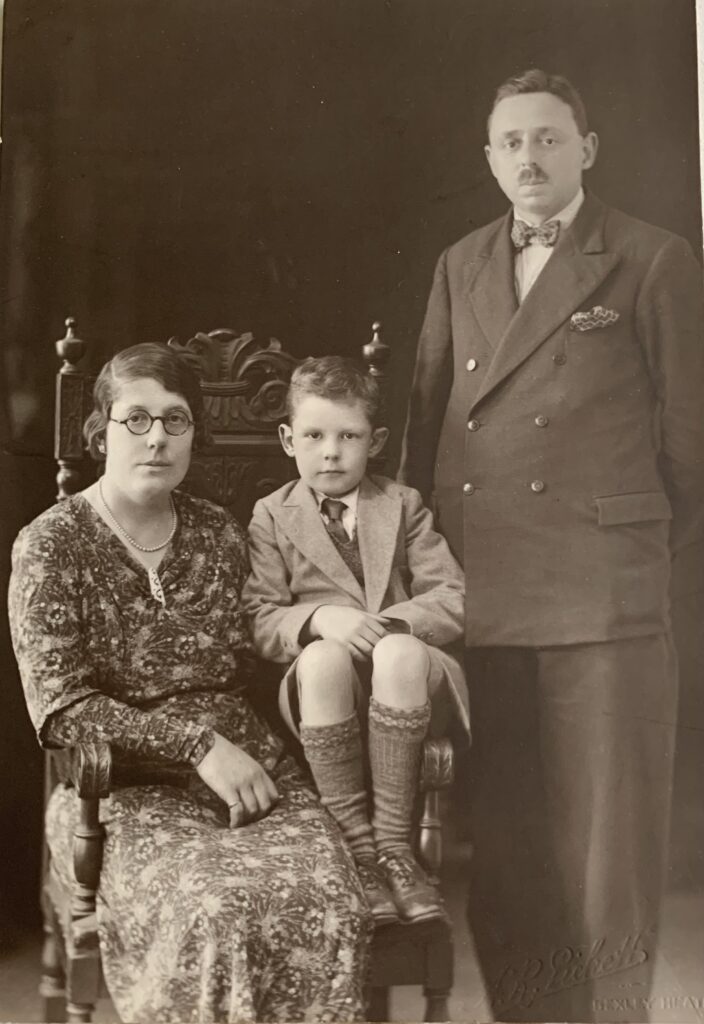
William Pook, his wife Mabel and their son Raymond Charles Audrey Pook, who was born in 1929.
In 1943 William was living in Cambridge. According to his sister Florenz, he was also awarded the Defence Medal 3/9/1939 – 2/9/1945. It would appear that he was a member of the Home Guard or Dads Army as it was affectionately known, and it seems he was a bombing/hand grenade specialist. His signed Postcard/photo and the inscription he wrote on the back appears below.
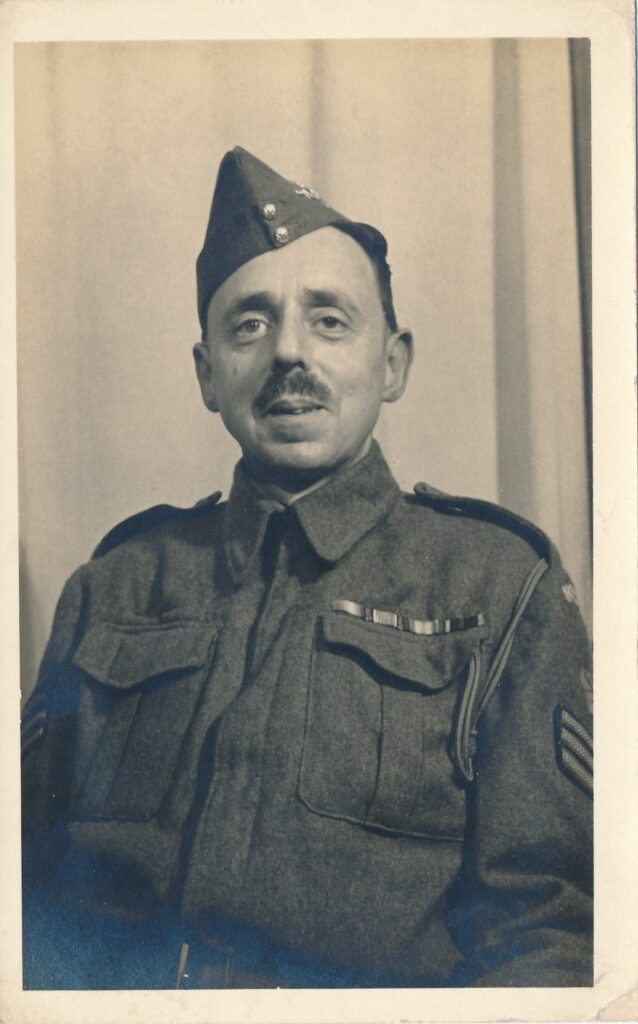
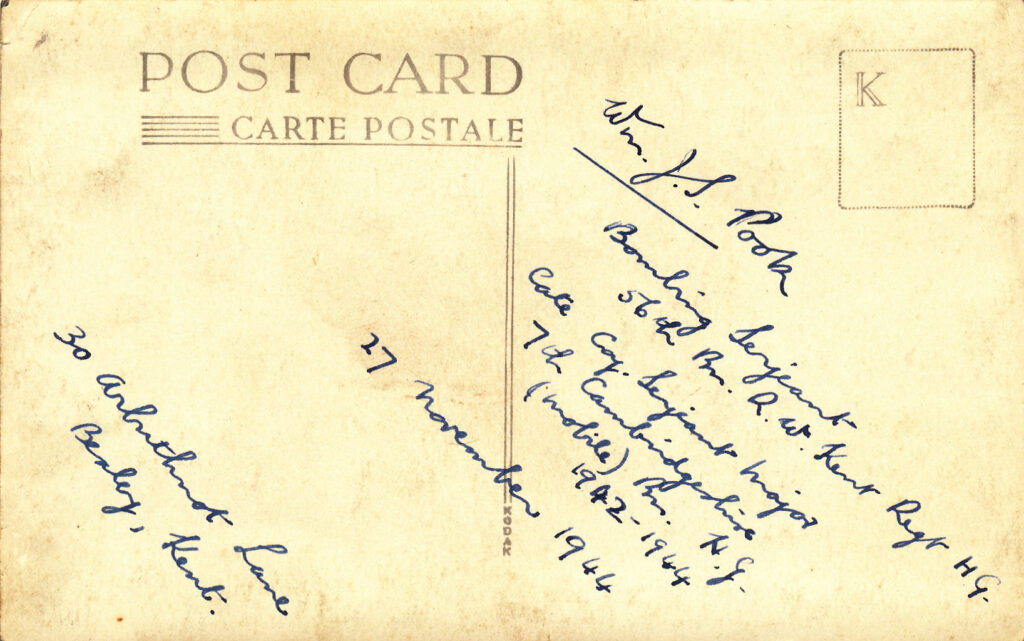
Transcribed from back of photo of W J S POOK – From WW2
Wim. J. S. POOK Bombing Sergeant 56th Bn R W Kent Rgt H.G. (HOME GUARD)
Late Coy Sergeant Major 7th Cambridgeshire (Mobile Bn) H.G. (HOME GUARD)
1942 – 1944 27 NOVEMBER 1944
In 1953 William and Mable lived at “Clinger”, Arbuthnot Lane, Bridgen, Nr. Bexley, Kent. He took great pride in looking after his garden which consisted of a lawn, apple trees, rock garden and vegetable garden. Mable did not like her mother-in-law Annie Pook, and in fact nick-named her the “Mad Irishwoman”. Much later in their life William, Mable and Raymond moved to 34 Grand Drive, Herne Bay, Kent.
Their son Raymond Charles Audrey Pook was born in 1929 in Dartford and died in 1994 of lung cancer (he smoked a lot). Raymond was in the Scots Greys for a while. He started up a taxi service in Sittingbourne called “Pook’s Taxis”! He married Alma Martin in Bromley in 1950 and they later divorced, they had no children. After his divorce he was with his common law wife and they lived in the Medway Towns for a while.
The Family Trees copied below were researched and drawn up by William Pook a few years before he died.

